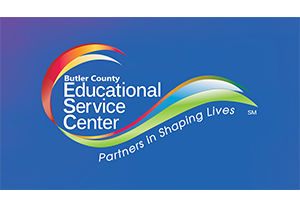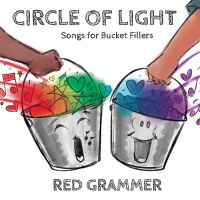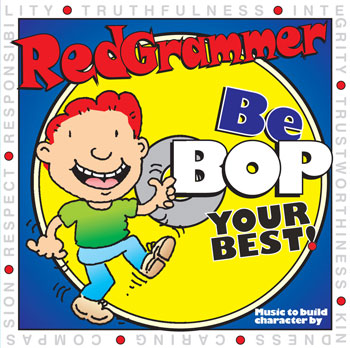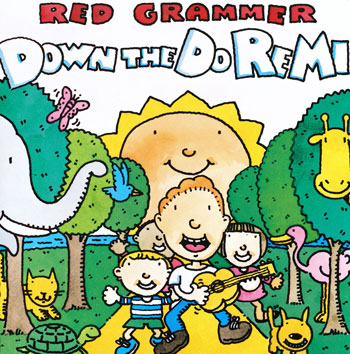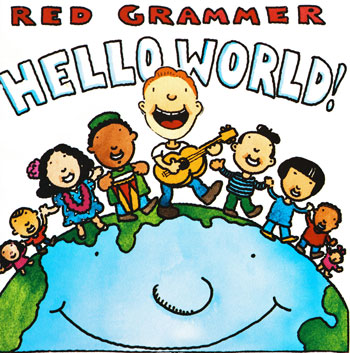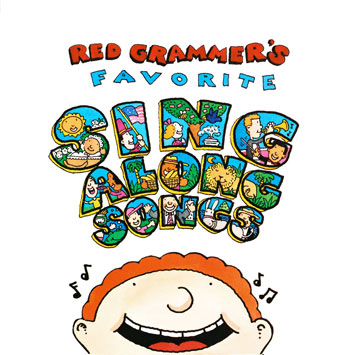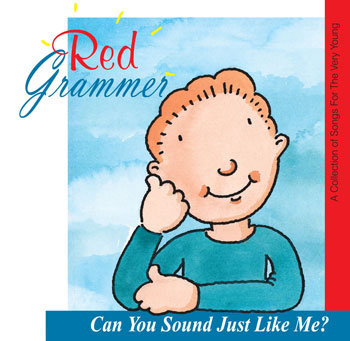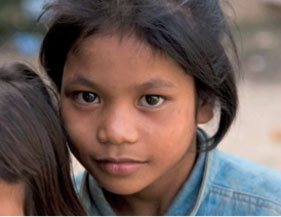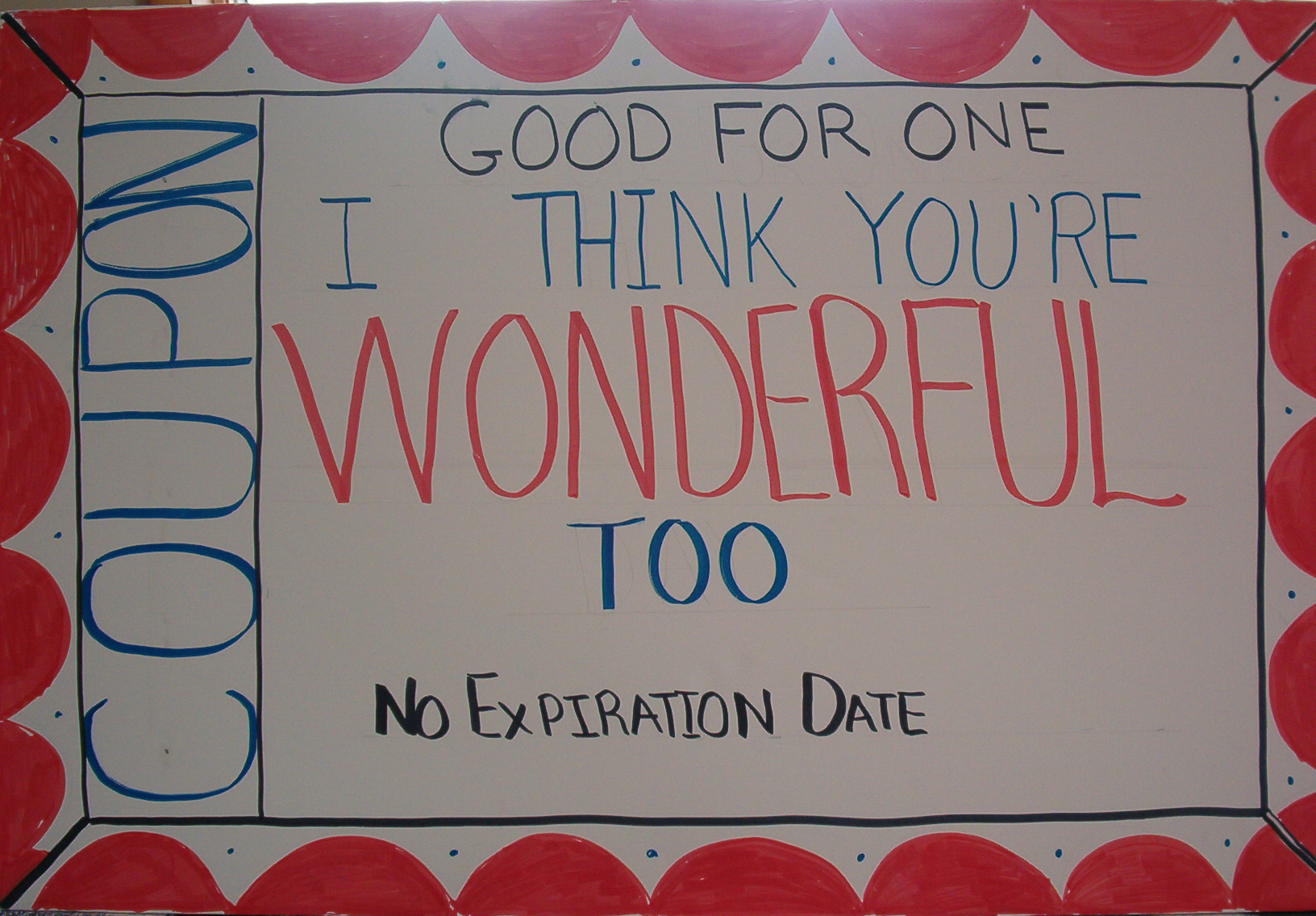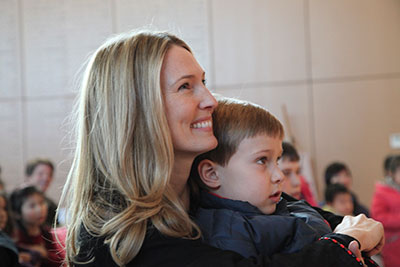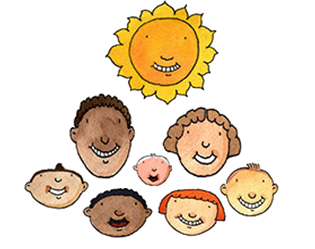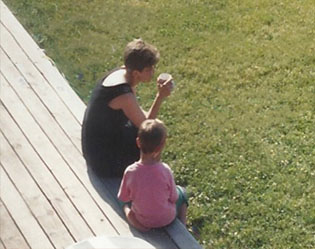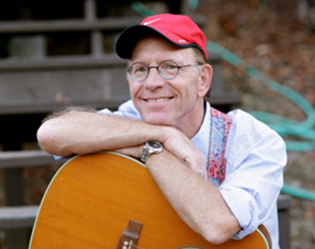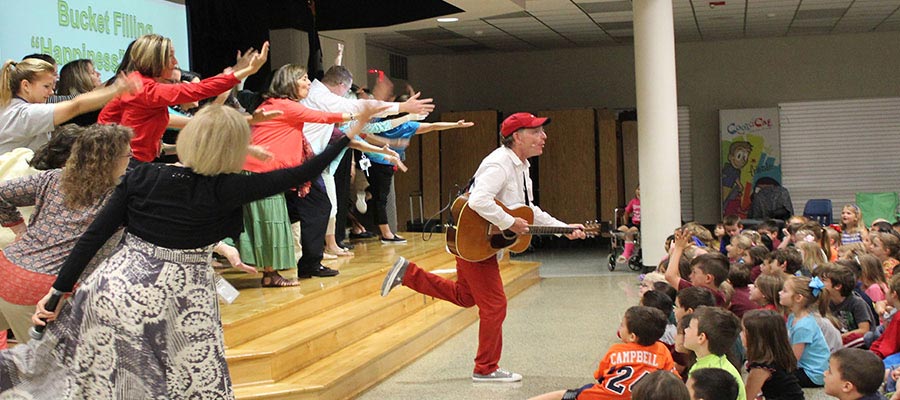ACLD Teacher Workshop
Promoting Bucket Filling and Positive Behavior
Through Red Grammer's Music
Bucket Filling
Power To Change The World (Sign Language)
Everybody Here Has A Bucket (Motions)
Fill A Bucket (Round)
Circle of Light (Bucket Activity)
Welcoming
Thank You For Friends (Sign Language)
Valuing
On The Day You Were Born (Body Trace; Birthday Card)
I Think You're Wonderful (Coupon; Kraft Paper Kids; Sign Language)
ABC's Of You (Singing Telegram)
Caring
See Me Beautiful (Sign Language)
Fun together
Barnyard Boogie (Rooster Hats; Clucking Cups)
Down By The Sea (Motions)
There’s A Place For Everyone
Motion
Teaching Peace (Spiral March)
Skills
Use A World (Toothpaste)
When I Get A Feeling (When I Get A Peeling)
Shake Your Brain (Maraca)
Quiet Time
Rooster Hat
During a Red Day in the Syracuse Area, a kindergarten class made a rooster hat for the Barnyard Boogie out of poster board. All the students looked adorable in their hats while singing the Barnyard Boogie to Red. Poster board can be a little slippery so we redesigned the rooster hat and made it out of stiff felt. That is the picture that you see below. A mom from a pre-school in Syracuse used the design below but did not use stiff felt. Instead she used regular felt and cut the back of the white (where it sets on the back of a child's head) more in the shape of the back of a head. It fit on the child's head securely and did not need to be tied on to the child's head. That works much better!
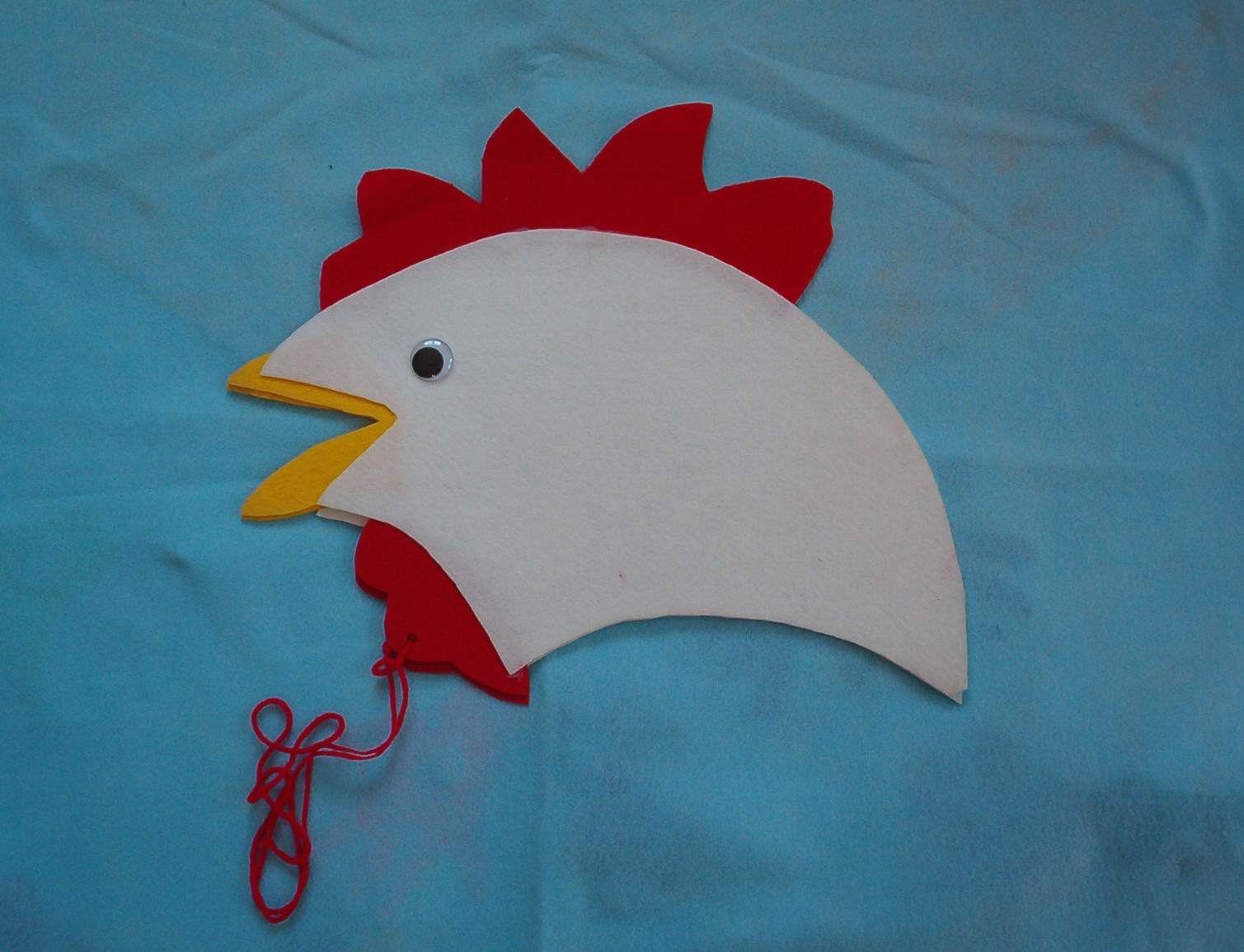
Materials:
1. 2 pieces of white stiff felt (24” x 14”)
2. 1 piece of red stiff felt
3. Some yellow stiff felt
4. Two 1” diameter googly eyes (I bought mine at a craft store)
5. Glue gun
6. Hot glue
7. Some red yarn
(See picture for pattern)
Procedure:
1. Make the comb (the crown) and the waddle using the red stiff felt and the picture below as your guide. The crown only needs to be one piece, but the waddle cut two pieces exactly the same.
2. Cut two pieces for the yellow beak using the picture below as your guide. Using the two white stiff felt pieces, cut two heads exactly the same using the picture below as your guide.
3. Hot glue one beak to the inside of a white stiff felt head and glue the other beak the other inside white stiff felt head. Then do the same with the waddles. Set the comb (crown) between the two white stiff felt pieces way at the top and hot glue the crown to the head and finish gluing the white stiff felt together at the top only. What remains opened (in other words, what doesn't get glued together on the head) is the bottom of the head and where the waddle and beaks are – that is where the child's head will fit into the hat.
4. Glue the eyes onto the head.
5. Punch a hole into the waddles and tie string or yarn through them so that a child can tie the hat securely onto his/her head.
Activity 1:
1. Play the Barnyard Boogie from Red's recording Teaching Peace
2. Talk about what a rooster looks like, how they act, etc. We've attached a link to a website that includes the anatomy of a rooster and hen as a guide for you:www.aces.uiuc.edu
3. Like the Barnyard Boogie, humans have different talents and can be unique in their own ways. Discuss what life would be like if everyone were exactly the same. Discuss how we can appreciate every one's talents and individuality.
4. If you have a shadow screen in your classroom, playing the Barnyard Boogie and wearing the rooster hats is so much fun when doing it behind the shadow screen. You could also use the rooster hats for a performance on a special day like Mother's Day, Grandparents' Day, etc.
Activity 2: A simple square dance for movement
This activity can be used with the rooster hats mentioned above. Students should be in 2 long lines facing each other. The lines should be about a foot apart.
|
I know a rooster down on the farm |
Both lines take 8 steps away from each other |
|
Everyday at dawn he sounds the alarm |
Both lines take 8 steps toward each other to be back at the beginning again. |
|
He doesn't do it like the other roosters do |
Both lines take 8 steps away from each other |
|
He sings, "Cock-a-doodle-oodie-oodie-oodie-oodie-oo" |
Both lines take 8 steps toward each other while flapping their arms like a rooster. |
|
Chorus: He's a swinging, singing rooster. He loves to improvise. He's the kind of clucker who was born to harmonize. |
Swing with the person in the other line that is standing in front of you. |
|
And everyday at dawn as the sun begins to rise you can hear him do the barnyard boogie |
Swing with your partner in the opposite direction. |
|
During the rooster sounds |
Both lines dance freely the way they think the rooster might be dancing |
|
Now all over the country everybody's heard |
Both lines take 8 steps away from each other |
|
About the Barnyard Boogie and the one they call the bird |
Both lines take 8 steps toward each other to be back at the beginning again. |
|
Bantams and Leghorns they can't resist the beat |
Line 1 bows to Line 2 then line 2 bows to line 1 repeat |
|
Bobbin' up and down while they're dancin' with their feet. |
Both lines bob up and down. |
|
Chorus: He's a swinging, singing rooster. He loves to improvise. He's the kind of clucker who was born to harmonize. |
Do-Sa-Do with the partner in front of you. |
|
And everyday at dawn as the sun begins to rise you can hear him do the barnyard boogie |
Do-Sa-Da in the opposite direction. |
|
During the rooster sounds |
Both lines dance freely the way they think the rooster might be dancing |
|
Verse 3: Repeat Verse 1 moves |
Materials Needed
1. One striped sock per student. Anklet to knee sock size works best. Booties or Footie Socks (socks that don't go past your heels) won’t work. We used black/gold stripes but using any colors for stripes makes for a more unique bee. We were able to find lots of striped socks in dollar stores. Often times the socks were 2 pair for a dollar.
2. One 12 inch pipe cleaner per student. We used black but feel free to be creative when it comes to color.
3. Two eyes per student. We used eyes that were ¾ inch in diameter.
4. Three Styrofoam semi-circles (with a 2 ½ inch diameter) per student.
5. Pattern for wings (see attached image).
6. Material to make wings.You can use construction paper, fun foam, stiff felt, or transparencies used from an overhead projector.
7. The song, Bebop Your Best from Red Grammer's recording, Bebop Your Best.
8. Glue, markers, scissors.
Activity
1. Play the song, Bebop Your Best and have students listen to the lyrics. Play the song again and this time have students sing the part “Be-bop your best” along with Red. You can give the students any kind of hand movement to use while singing the words “Bebop your Best”.
1. Have a discussion about what it means to “Bebop Your Best”.
2. Have students volunteer at what they are good at doing. Have students think about what they would like to work on being good at in the classroom for this year. It could be learning to tie their shoe or working on a character trait like being respectful.
3. Have students make a “Bee” bop (see instructions and image below).
4. Play the song again and the students can move their bee while singing the words “Bebop your Best”
5. Students can leave the bees on their desks as reminders or you can hang them on a bulletin board.
6. The bee could be a talisman for the students.
Make the Bee
NOTE: An image of the bee and an image of the wing pattern are at the bottom of this lesson.
1. Have students place the 3 Styrofoam semi-circles inside the sock so they lay side by side and represent the head, thorax and abdomen of the bee.
2. Tie a knot at the end of the sock. This will keep the Styrofoam semi-circles in place and the knot represents the stinger.
3. Take a pipe cleaner and cut it in half. Have the student push the 2 pieces of pipe cleaner into the front on the head of the bee. Then have the students twist the open end of each pipe cleaner into a circle to form the ends of the antennae.
4. With the help of an adult have the students glue the eyes onto the head of the bee.
5. Have students trace the pattern for the wings and cut out the wings. With younger students have an adult help or have the wings cut out ahead of time.
6. Have the student (or the teacher) write on the left side of the wings what the student can “Bee” bop their best at. On the right side of the wings have the student write what they want to work on (“Bee” bopping their best) during the upcoming school year.
7. Using a blunt pointed object like a butter knife or scissors, push the middle of the wings (the part that connects the wings) through the sock and into the Styrofoam semi-circle that is in the middle of the sock (the semi-circle that represents the thorax of the bee).
Extension
1. Read a story about bees. Two good books are The Honey Bee by Paula Hogan and The Magic School Bus Inside the Bee Hive by Joanna Cole. Point out that honey bees are hard workers and bees work together to get the job done. As students in the classroom, they should be like bees working hard together to get the job done.
2. Using the bee that students made from this lesson, have them review the parts of the honey bee: abdomen, antennae, head, thorax, eye, stinger, wings. Note: We have not used legs or the pollen baskets on the bees made in this lesson. You could have the students say what body part is missing. You could also have the students add legs to their bees.
Images
Objective
To support and develop each child's uniqueness at being their best.
Materials
Lamps of different shapes and styles
Pictures of unique lamps (We used google.com)
Strips of colored construction paper
Picture of each student in the class (head shot is al you need)
Pattern of hands and feet
CD player
Lesson
1. Play the song Bebop Your Best. While the song is playing, do some simple hand motions that students can follow along. Be sure to include some motions that cross the midline. When you get to the part where Red sings the words “Bebop Your Best” put your hands in the closed fists near your face. Have your hands pop open to the beat of the music. Your fingers will all point out (it gives the impression of a light blinking on and off). This is great for pre-school and Kindergarten classes. For older students you could have a student leader come up with movements. Go around a circle and each child adds one new movement.
2. Turn on the lamps of different shapes/styles. Talk about and point out the differences in the lamps. Ask what is the one thing that is the same for each lamp? (all the lamps give us light to be able to see no matter what shape or size). Explain that we are like lamps. We all might look different but each of us “shines” in our own unique way.
3. Have students pick out a lamp picture. Have each child glue their picture on the lamp shade of the picture.
4. Give the students 4 strips to add for legs and arms. The students can make the strips as long or as short as they would like and some students might even bend them into an accordion shape.
5. have students draw hands and shoes to add to the strips. For little ones you may have to supply the hands and feet for them to glue on.
6. Hang the pictures from the ceiling or put them on a bulletin board that says “Shine on and Bebop Your Best”
Bend, Oregon Teacher Workshop
Teaching Peace
If peace can be seen not as the quiet, static "end of the story", but rather as a vibrant engaging place where our diversities are fascinating, our creating, working and playing together exhilarate us and foster a vision of the future that is compelling and hopeful, then it will be a place that all children will long for and work to bring into being. When we know that we belong and are loved and valued it is much easier for us to show up postively in our environment. It is my hope that the following songs and activities will help bring added playfulness, love and acceptance to your classroom community and will help nurture a kind of peace among your students that brings light to their eyes and excitement and possibility to their hearts.
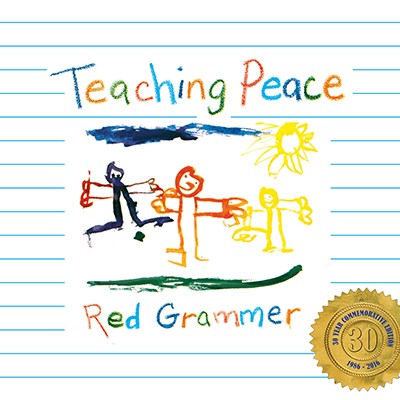
Teaching Peace (Spiral March)
Say Hi! (Circle Activity)
I Think You're Wonderful (Coupon; Sign Language)
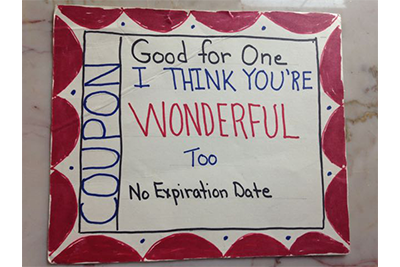
Rapp Song (Tootsie Pop Activity)
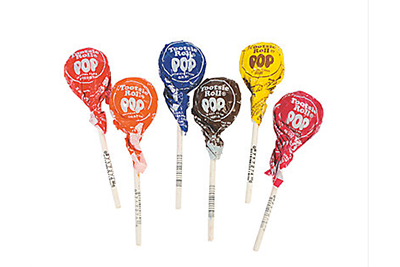
Barnyard Boogie (Rooster Hats; Clucking Cups)
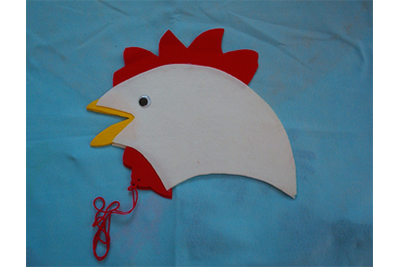

Use A World (Toothpaste)
See Me Beautiful (Kraft Paper Kids)
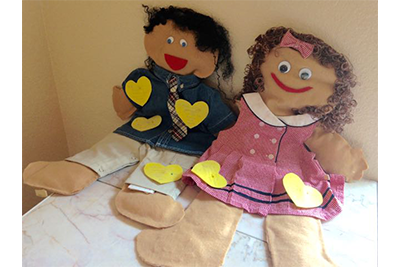
"See Me Beautiful" Glasses
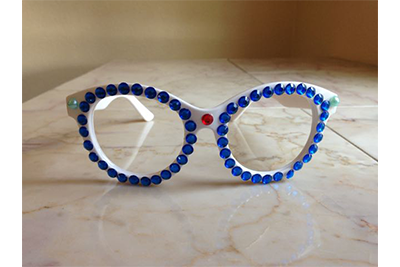
Shake Your Brain (Maraca)
Buono Appetito (food)
On The Day You Were Born (Body Trace; Birthday Card)
ABC's Of You (Singing Telegram)
Thank You For Friends (Sign Language)
Bucket Filling
Bucket Filling is a wonderful approach to building a peace-filled, loving energy in your classroom. The following three songs are from my latest recording, Circle of Light: Songs For Bucket Fillers.
Power To Change The World (Sign Language)
Everybody Here Has A Bucket (Motions)
Circle of Light (Bucket Activity)
Big Brass Band Lesson
Materials needed:
- Clip art of drums, horns, cymbals and flutes.
- Enlarge the pictures on poster board and cut out.
- Some instruments like the drum or french horn will need string so the instrument can be placed on the student.
- The song the Big Brass Band from the recording, Can You Sound Just Like Me?
Activity:
- Show pictures of the different instruments used in a band. Better yet, have some high school students come in and bring their instruments to show and play so that students can listen to the different sounds. Discuss with students which instruments make low, high sounds. Have the students experiment trying to make the different sounds with their voices.
- Play the song Big Brass Band and have the students listen for the sounds of the different instruments and "play along" with their voices. For example: In the song, Red Grammer sings, "Here come the horns and they're playing out loud, Let's play like a big horn now" and then Red makes the horn sound with his mouth. Here the students can mimic the horn sound along with Red.
- On the same day or on another day, pass the poster instruments out to the students. You can have one for each student or have a few so that the students can learn to take turns.
- Play the song again and the students "play" their instrument where their part comes up in the song and imatating the sound with their voice.
- At the end of the song when all the instruments are being played at the same time, all the students play their instruments and make the sound with their voices and march around the room.
- Another time, have the instruments spread out on the floor in the middle of the room. Have students line up and call upon students to run to the center pick up an instrument and mimic the sound. You might have everyone whose first name begins with the letter "B' run to the center and pick up the cymbals to play, etc. At the end of the game each student picks up an instrument and plays along with the song, Big Brass Band.
Bucket Fillers, That's Who We Are - March and Motions
For Younger Students
Materials Needed: The students will need their Bucket Filling buckets. It they don't have an actual bucket they can use a picture of a bucket.
Preparation:
Line students' buckets around the classroom in a formation so that students can march around the buckets.
Activity:
Play the song, "Bucket Fillers, That's Who We Are" as students march around the classroom. When the song gets to the chorus the students stop in front of the nearest bucket and do the following motions
- "Bucket Filling, That's What We Do Here" - Pick up the bucket in front of you with one hand, with the other hand point your finger down into the bucket to show that you are trying to fill the bucket.
- "Bucket Filling, That's Who We Are" - set the bucket back down and with the index fingers point to yourself near your shoulders.
- "When a Bucket Needs Some Filling" - Same thing as step one only don't pick up the bucket. Use the sign language for bucket which is to have a fist in front of you and move it up like you are lifting a bucket by the handle (see http://www.babysignlanguage.com/dictionary/b/bucket/)
- "A Kind Word and a Helping Hand" - cup one hand near your mouth like you are shouting something and then extend your hand out with palm out to show that you are giving your hand.
- "A Perfect Way to Start" - Swing your arm up with a closed fist from your side to in front of your body, like you might be shouting "hurray".
- Go back to the first step for the next verse and repeat.
- Repeat chorus motions from steps 1-5.
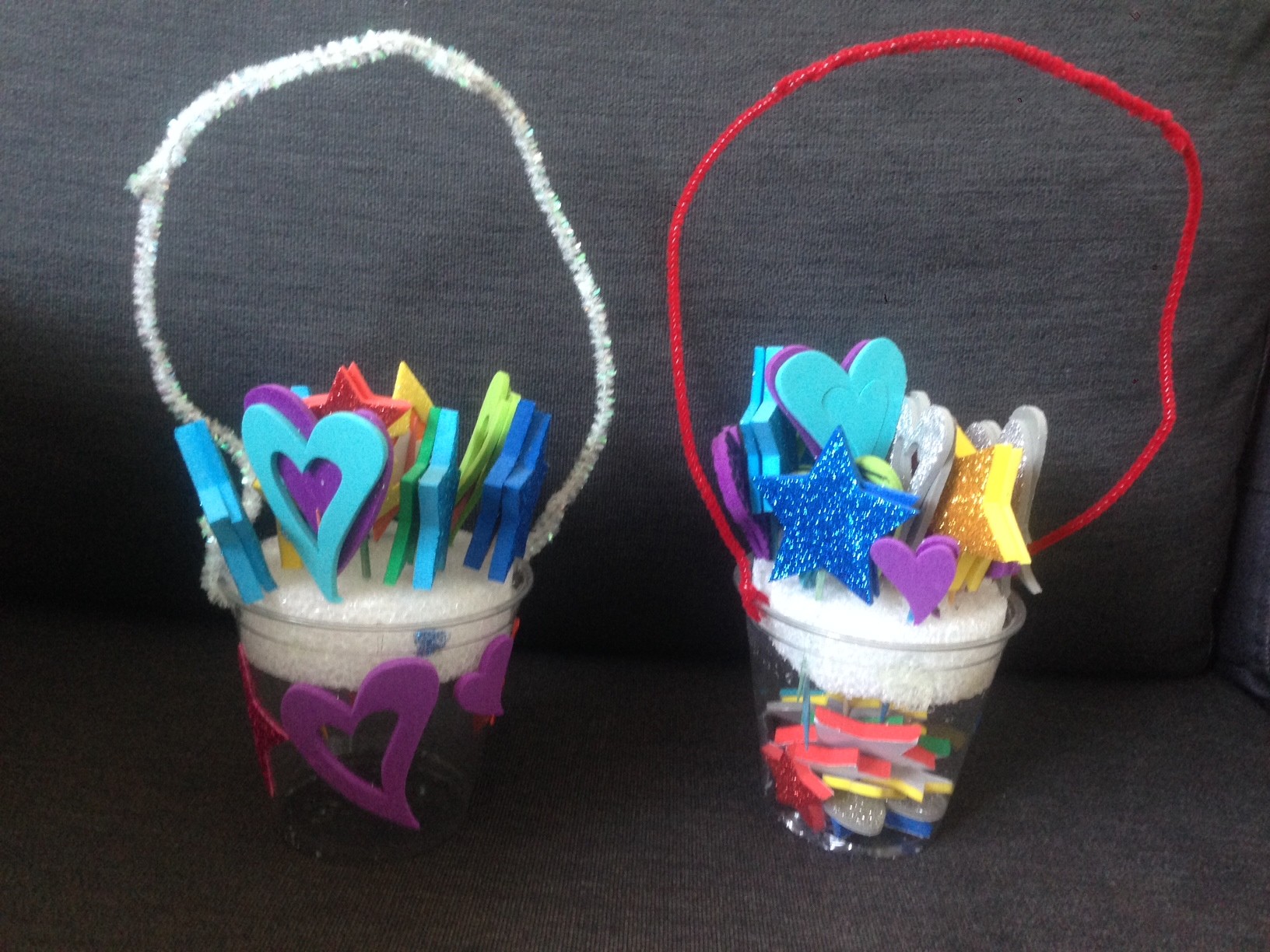
Signs and Buttons
You can also march around the classroom or in the school building wearing buttons and carrying signs.
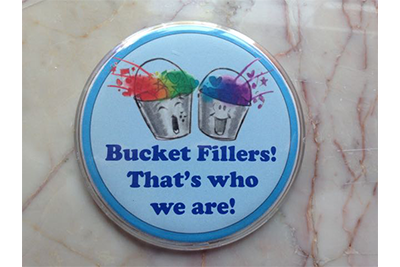
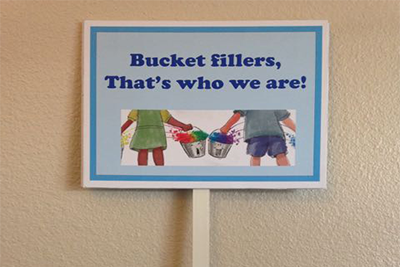
Red Grammer Bucket Filling Workshop
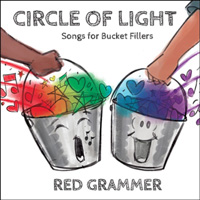
This page is a recap of the ideas, songs and activities covered in the workshop. The links in red will take you to each song's lyric page that features an audio player of the song, videos showing the sign language when available, and links to the song's accompanying activities. Have fun!
Power To Change The World Power To Change The World (Sign Language)
History of Bucketfilling
Donald O. Clifton
The Bucketfilling model was conceived by Dr. Donald O. Clifton. In his research into why US POWs in the Korean War had the highest mortality rate of any war despite a lack of unusual physical abuse he discovered that it was the N. Koreans' intentional breaking down and destruction of the human connections between the US prisoners that caused them to give up and die. In thinking about the dire consequences of this kind of dismantling of support and caring he began to investigate its opposite. What would happen if time and energy and care were given to building connections between people. This began his life's work which has led him to be called the Father of Positive Psychology.
From his work he developed the concept of everyone having an invisible "bucket" inside of them that holds all their good feelings about themselves. When our bucket is full we are happy and everything seems possible. When it is empty we are sad and depressed and defeated.
Carol McCloud

Early childhood educator, Carol McCloud, found this model to be a simple and effective way to develop and support the pro-social behaviors and interactions with her students. Sensing a need she wrote the best-selling picture book, "Have You Filled A Bucket Today?" which brought bucketfilling to early childhood and elementary education.
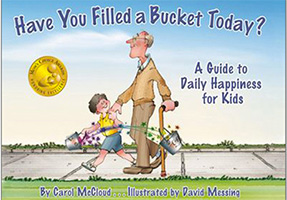
There are three rules of bucketfilling:
Bucket Filling Rule #1: Fill Other's Buckets
Fill A Bucket (Round)
Bucket Filling Rule #2: Don't Dip
Help children distinguish between bucket filling and bucket dipping by playing "Thumbs Up/Thumbs Down" with various scenarios.


Bucket Filling Rule #3: Use Your Lid
Bucket filling and bucket dipping are both contagious.
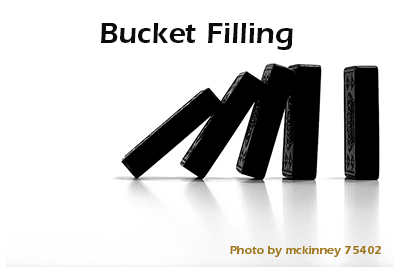
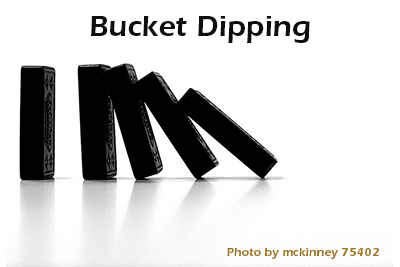
When we use our lid we stop the "dipping energy" and change the outcome.
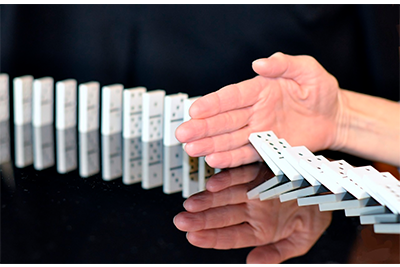
Fill EVERYONE'S bucket:
Introvert, extrovert, happy, sad, easy, difficult
"5 Minute Rule" - When you meet someone give them 5 minutes of kindness, caring, love, and safety. If you do they will usually begin to show up with their true, wonderful self.
Creating A Bucketfilling Environment With Songs, Stories and Service
Bucketfilling Songs For Kindness and Empathy
See Me Beautiful (Sign Language)
Kraft Paper Kids - Instructions

"See Me Beautiful" Glasses

I Think You're Wonderful (Sign Language and Coupon)

Bucket Filling All The World Around
Rapp Song (Tootsie Roll Pops) - "We all look different, but we're all the same."

Teaching Peace (Sign Language, Spiral March)
Bucket Filling For The Planet
Fill My Bucket With Fun
These are great songs to use to hit the "reset" button in your classroom and have a collective experience of fun.
Barnyard Boogie (Rooster Hats, Clucking Cups)


Down By The Sea (Motions, Make Up New Verses)
Building A Bucket Filling Identity and Culture
Songs and art
Everybody Here Has A Bucket (Bucket Hat)
Bucket Fillers, That's Who We Are (March, buttons and signs)
Click on images for pdf templates of buttons and signs


I Am A Bucket Filler (Videos, bracelet)
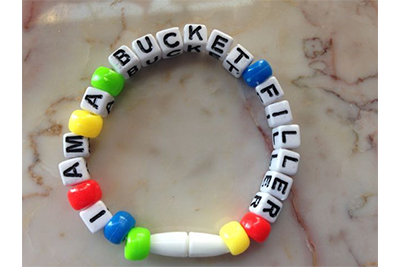
Circle of Light ("Bucket of Light" Circle Time, Energy Ball)
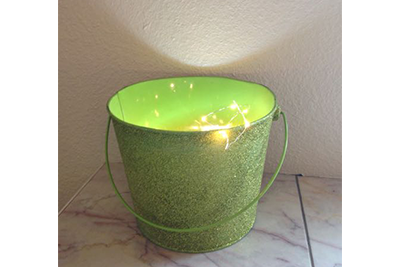
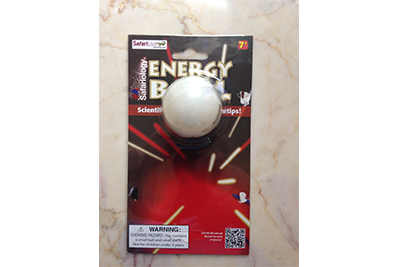
Stories
Sharing your own bucketfilling experiences with the children is a powerful way for them to connect to the ideas involved.
Service
Doing classroom service projects in the context of bucketfilling helps the meaning of the activity become more concrete to young students.
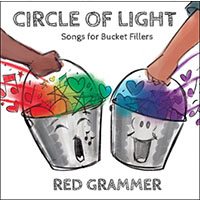

Bucket Filling
Bucket Filling brings increased happiness, love and thoughtfulness in our schools, homes and communities. "Circle of Light: Songs for Bucket Fillers" adds the power of music to the building of Bucket Filling culture musically.. This collaborative effort between Red Grammer and Carol McCloud, author of the best-selling book, "Have You Filled A Bucket Today?", has resulted in ten irresistible songs that children instantly connect to and integrate into their lives. Check out the songs below and see how they can amplify the Bucket Filling culture in your class, school community or home.
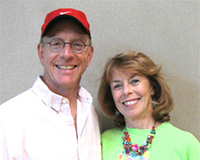
Circle of Light:Songs For Bucket Fillers
Great bucket filling songs from Red's other albums:

Red Grammer "Hello World" Workshop
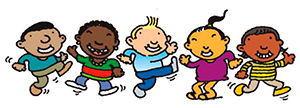
This page is a recap of the ideas, songs and activities covered in the workshop. The links in red will take you to each song's lyric page that features an audio player of the song, videos showing the sign language when available, and links to the song's accompanying activities. Have fun!
Where The World Is Going
Changing Demographics -
USA Today Diversity Index... by County

The world is getting smaller. And our particular part of the world is getting more diverse.
Which presents us with two questions:
1. Do we teach our children to be afraid of, or open to, this changing world?
(What will serve them best?)
2. Are we learning how to honor the diverse cultures some of our children bring to our programs and how, when necessary, to respectfully help those children add to their skill sets to succeed in our educational system?
How We Are Different & The Same
In most ways we are the same... we all eat, dress, speak, hope, dream, come from families, and often sing/dance/pray and on and on...
How we express these are a manifestation of our "culture".
Language
The Rapp Song (Tootsie Pops)
I Think You're Wonderful (translations)
I think you’re wonderful… when somebody says that to me
I feel wonderful as wonderful can be
It makes me want to say the same thing to somebody new
And by the way I’ve been meaning to say , “I think you’re wonderful, too”
Russian translation & transliteration
Vwee u di vit ilnee
Kogda eh dta min yeh gu vuhr yat
Syoe u di vit ilna
Ee shast yoo nyet pri grad
Ee min yeh ha teel is bwee
Al vyeht it slova me lub vee
Pro sta ca moo ni bootreeya dum ska zat
Kak u di vit il nee vwee
Hawaiian translation & transliteration
Ku pa-ia na-ha-no-o e
La ha-i-e ha-i ma-i-ai __
Ko mo i ke ku pai a na ha
Me ka nui i hi ki __
E ha i li ke-a ku
Vau i-a ha i hou __
A u a mana o vau e ha-i-a o-e
Ku pai-a naha no oe __
Barnyard Boogie (Rooster crows around the world)
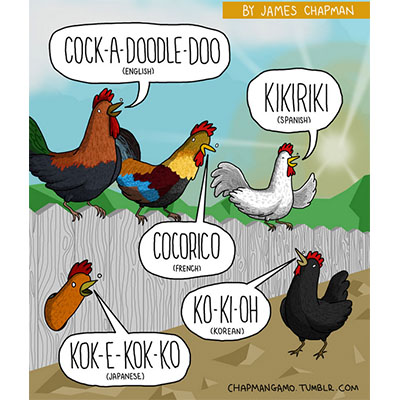
Food
Playfulness
Qualities of Openness
Everyone is welcome here
Curiosity
Where are our students from?

Not being afraid to ask questions
Developing Sensitivities and Awarenesses
Peekskill, NY 1985
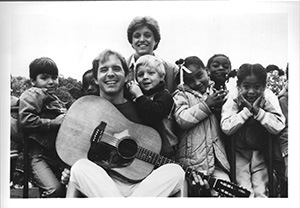
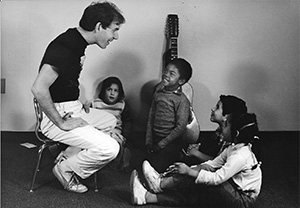
Leozy Cumbertson
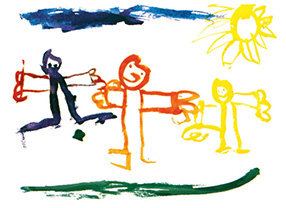
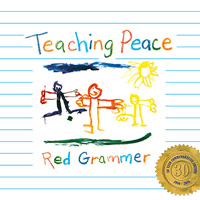
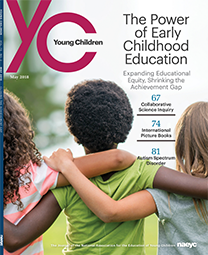
Young Children - May 2018 Issue
Becoming Upended: Teaching and Learning about Race and Racism with Young Children and Their Families
Kirsten Cole, Diandra Verwayne
Awareness of the Power of Story: Who's Speaking and Whose Stories Are Getting Told
Stocking Your Library with Equitable and Inclusive Children’s Titles
- Lee & Low Books—leeandlow.com
- We Need Diverse Books—weneeddiversebooks.org
- Social Justice Books: A Teaching for Change Project—tfcbooks.org/best-recommended/booklist
- Raising Race Conscious Children—raceconscious.org/childrens-books/
Families’ Internal Conflict Between Assimilation & Retaining Culture
Elements of Culture That Can Be Learned About
Names - Ups and downs to learning their real names
Food - Families are usually very happy to share
Holidays/Holy Days - Families are usually very happy to share
It’s All About LOVE!
Caring and Compassion Activity Using Mirrors
Definition
Showing concern for the well-being of others; having regard for another's needs
Literacy
Wilfrid Gordon McDonald Partridge by Mem Fox
Now One Foot, Now the Other by Tomie de Paola
The Teddy Bear by David McPhail
When I am Old with You by Angela Johnson
Wednesday Surprise by Eve Bunting
Materials Needed
1. Mirrors for students. You can get small hand mirrors at a dollar store (usually sold 2 for $1.00) so that each group of students has one mirror for each group.
2. Clue sheets that are printed backwards. To print the clues backwards on a computer you should print out the sentence then save it as a jpeg.
3. The song “Caring and Compassion” from the recording, Bebop Your Best
4. A chart that lists at least 12 character traits. You can choose the list from Red's recording, Bebop Your Best.
Activity 1: The Mirror Game
(looking past ourselves)
1. Have students in 10 small groups.
2. Have each student in the group look at themselves in the mirror and either think about or say out loud what they see.
3. Have each student move the mirror to a position so that they see another student(s) in the group and describe what they see. Explain to the students that they will be talking about a new character trait today. In order to do this character trait they must look beyond themselves and look at others closely.
4. In order to find out what new trait they will be discussing they need to find the clues in the classroom. Have posted in your classroom on large paper backward clues. Each group must find one of the clues and use their mirror to figure out the clue.
5. When every group has a clue they will share the clue and you can list them on the board. You may need to discuss the clues as a large group. It helps to have a list of character traits for the students look at.
6. With primary students you can give them a hint by playing Red's song, “Caring and Compassion” and have them listen for a clue in the song for the character trait. With older kids they should be able to guess the clue. When the students guess the right answer, go over the clues again to show why caring and compassion is the right answer.
7. Play the song “caring and compassion” from Bebop Your Best
Celebrating Connections 2017 Workshop
Using Music to Build a Happy, Caring and Connected Classroom
We all want to know that we belong, are loved and valued. We can create classroom communities that communicate this to every child, everyday. During the workshop, songs and activities will be shared that encourage courtesy, kindness, and respect for children ages four and up. Activities and movements will be presented that are fun, get children actively involved, engage student's imagination and increase student's cooperation and language skills.
Welcoming Connections
(Hint: if you have some children who often do not cooperate - stand at the classroom door everyday and welcome each child as they come in. Watch the change over weeks in the connection the children have with you.)
Thank You For Friends (Sign Language) This is also a great song to end the day...one more connection before everyone goes home. When the students are all lined up, have them look around for a friend. Sing the song together and have the students put in their friend's name.
Valuing Connections
On The Day You Were Born (Body Trace; Birthday Card)
I Think You're Wonderful (Coupon; Sign Language)
ABC's Of You (Singing Telegram)
Caring Connections
See Me Beautiful (Kraft Paper Kids)
Fun Together Connections
Barnyard Boogie (Rooster Hats; Clucking Cups)
There’s A Place For Everyone Connections
Respect (Sign Language)
Hope Connections
Teaching Peace (Spiral March)
Skill Connections
Use A World (Toothpaste)
Shake Your Brain (Maraca)
Bucket Filling Connections
Everybody Here Has A Bucket (Motions)
Circle of Light (Bucket Activity)
Celebrating Mother Nature
Red Grammer
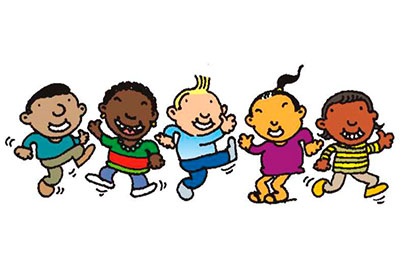
This page is a recap of the ideas and songs in the workshop. Many of the songs in this workshop are new and will be on my upcoming new album: Hooray For The World. Till then there are links to video clips of me performing eacg song in one of my weekly Thursday online concerts.
The "red" bolded & underlined song titles are all links to videos of Red singing the songs.
Most studies agree that kids who play outside are:
+ smarter
+ happier
+ more attentive
+ less anxious... than kids who spend more time indoors.
Playing outside in Nature…
Builds confidence –
The way that kids play in nature has a lot less structure than
most types of indoor play. There are infinite ways to interact
with outdoor environments, from the backyard to the park to
the local hiking trail or lake, and letting your child choose how he treats nature means he has the power to control his own actions.
Promotes creativity & imagination –
Unstructured nature play also allows kids to explore and
interact organically with their surroundings. In this open-ended
environment they can think more freely, design their own
activities, and approach the world in inventive ways.
Teaches responsibility –
Things in nature are alive. If they are mistreated or not taken care
of properly they will die, and entrusting a child to take care of the living
parts of their environment means they’ll learn what happens when they forget to water a plant, or pull a flower out by its roots.
Provides a variety of rich stimulation –
Nature activates more senses—you can see, hear, smell, and touch the outdoor world. “As the young spend less and less of their lives in natural surroundings, their senses narrow,” Richard Louv warns, “and this reduces the richness of human experience.”
Gets kids moving –
Interacting with nature involves more exercise than sitting on the couch. Your kid doesn’t have to be joining the local soccer team or riding a bike through the park—even a walk will get her blood pumping.
Makes kids think –
Nature creates a unique sense of wonder for kids that no other environment can provide. The things that occur naturally in backyards and parks everyday make kids ask questions about the earth and the life that it supports.
Reduces stress and fatigue –
According to the “Attention Restoration Theory”, urban environments require directed attention, which forces us to ignore distractions and tires out our brains.
In natural environments, we practice an effortless type of attention known as soft fascination that creates feelings of pleasure, not fatigue.
Helps mitigate ADHD –
Outdoor time has a dramatic impact on children’s ability to focus and on school preparedness, including a reduction in ADHD symptoms —
a problem that has exponentially increased over the last several decade
“…compared to the after effects of play in paved or indoor areas, activities in natural, green settings were far more likely to leave ADD children better able to focus, concentrate. Activities that left ADD children in worse shape were far more likely to occur indoors or outdoors in spaces devoid of greenery.”
Environment and Behavior Human-Environment Research Laboratory, Univ. of Illinois –
Andrea Faber Taylor, Frances Kuo, and Willian C. Sullivan
But most children are not reaping these benefits–
Children on average spend only 4 - 7 minutes a day in unstructured outdoor play, such as:
- like climbing trees
- drawing with chalk on the sidewalk
- taking a nature walk
- playing a game of catch.
Instead, kids spend more than 7 hours each day in front of electronic media.
And preschoolers are similarly impacted -
Most little ones log an excess of 32 hours per week of TV, according
to The Nielsen Company.
By the time most children attend kindergarten, they have watched
more than 5,000 hours of television, the time it can take an adult to complete a college education.
And this is during their most impressionable years, a time when their brains are developing connections faster than at any other time in their lives.
Over the last twenty years:
- Childhood obesity rates have more than doubled. 7
- The United States has become the largest consumer of ADHD
medications in the world. 8
- The use of antidepressants in pediatric patients has risen sharply.
7. CDC’s National Center for Chronic Disease Prevention and Health Promotion. Division of Adolescent and School Health. Childhood Obesity. 20 Oct. 2008. http://www.cdc.gov/HealthyYouth/obesity
8. Sax, Leonard, “Ritalin - Better Living Through Chemistry?” The World and I. Nov. 1, 2000.
“Sixty minutes of daily unstructured free play is essential to children’s physical and mental health.” American Academy of Pediatrics
According to one study, children’s stress levels fall within minutes of seeing green spaces, a simple, no-cost and time-efficient antidote for stressed-out kids.
Kuo, PhD, Frances E., & Andrea Faber Taylor, PhD. “A Potential Natural Treatment for Attention-Deficit/Hyperactivity Disorder: Evidence From a National Study.” American Journal of Public Health 94.9.Sept. 2004. http://www.pubmedcentral.nih.gov/articlerender.fcgi?artid=1448497
“When we go outside, my kids become their best selves. Gone are the petty arguments about whose turn it is or what to do next.
Suddenly the kids are creative—digging in the dirt, picking up worms, jumping and laughing.”
Renee Limon, co-founder of Enviromom.com
So how do we bring more nature into our students lives?
Spend More Time Outside
There's A Garbage Dump Out My Backdoor
Bring Nature Into Our Indoor Spaces
Connect the indoors to the outdoors –
- put a bird feeder outside the window
- provide binoculars
- bring natural materials indoors
- provide a place for wet and muddy gear
- use ceramic plates, cloth napkins, etc.
Use Music!
The Beyond
- Taking daily excursions beyond the boundaries of the
fenced play area.
- Connecting the children to the more wild, authentic, and
unkempt natural world around them.
- Having the children revisit ecosystems over the course of the year,
learning about seasonal changes over time.
- Sometimes doing planned activities in these wild places,
sometimes just embracing the outdoor experience.
Nature Treasure Map https://juniornaturalistclub.com/videos/
Make A Start
- Start the day with outdoor play
- Increase the amount of time outdoors
- Increase teacher-child interactions in the outdoor play space
- Create a separate zone for natural materials and loose parts
though man-made playground equipment may be present
- Bring indoor materials outside: books, art supplies, blocks
- Have snack time outdoors in the play area
Celebrate the good news! (there’s a lot of it)
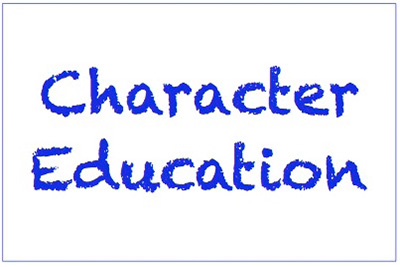
Schools use Red Grammer's music as a powerful addition to their character education programs because it playfully and thoughtfully brings to life the elements of character in tangible ways for their students and staff. It is one thing to talk about character... it is another to joyfully sing about it.
The songs on Red's Grammy-nominated CD "Bebop Your Best" like "Fairness", "Respect", and "Gratitude" artfully label and define the behaviors that make up specific character traits. Check them out below. (A special gem that can become a powerful theme song for your intermediate grades is "Listen To Your Heart".)
For songs that evoke these traits more indirectly like "See Me Beautiful" or "Two Hands, Four Hands" give a listen to the many wonderful songs listed below from Red's other albums.
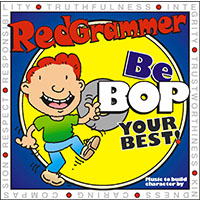
Bebop Your Best: Songs To Build Character By
Songs from Red's other Award-Winning CDs
Respect
Gratitude/Thankfulness
Thank You For Friends
Excellence
Responsibility
Cooperation
Kindness
Caring and Compassion
Appreciation/Love
Inclusiveness/Community
Unity
Peacefulness
Consideration
Openness
Self-Awareness
Hopefulness
It's Another Beautiful Morning
Red Grammer Bucket Filling Workshop - Cherokee Elementary
This page is a recap of the ideas, songs and activities covered in the workshop. The links in red will take you to each song's lyric page that features an audio player of the song, videos showing the sign language when available, and links to the song's accompanying activities. Have fun!
Power To Change The World Power To Change The World (Sign Language)
History of Bucketfilling
Donald O. Clifton
The Bucketfilling model was conceived by Dr. Donald O. Clifton. In his research into why US POWs in the Korean War had the highest mortality rate of any war despite a lack of unusual physical abuse he discovered that it was the N. Koreans' intentional breaking down and destruction of the human connections between the US prisoners that caused them to give up and die. In thinking about the dire consequences of this kind of dismantling of support and caring he began to investigate its opposite. What would happen if time and energy and care were given to building connections between people. This began his life's work which has led him to be called the Father of Positive Psychology.
From his work he developed the concept of everyone having an invisible "bucket" inside of them that holds all their good feelings about themselves. When our bucket is full we are happy and everything seems possible. When it is empty we are sad and depressed and defeated.
Carol McCloud
Early childhood educator, Carol McCloud, found this model to be a simple and effective way to develop and support the pro-social behaviors and interactions with her students. Sensing a need she wrote the best-selling picture book, "Have You Filled A Bucket Today?" which brought bucketfilling to early childhood and elementary education.

There are three rules of bucketfilling:
Bucket Filling Rule #1: Fill Other's Buckets
Fill A Bucket (Round)
Bucket Filling Rule #2: Don't Dip
Help children distinguish between bucket filling and bucket dipping by playing "Thumbs Up/Thumbs Down" with various scenarios.


Bucket Filling Rule #3: Use Your Lid
Bucket filling and bucket dipping are both contagious.


When we use our lid we stop the "dipping energy" and change the outcome.

Fill EVERYONE'S bucket:
Introvert, extrovert, happy, sad, easy, difficult
"5 Minute Rule" - When you meet someone give them 5 minutes of kindness, caring, love, and safety. If you do they will usually begin to show up with their true, wonderful self.
See Me Beautiful (Sign Language)
Kraft Paper Kids - Instructions

"See Me Beautiful" Glasses

I Think You're Wonderful (Sign Language and Coupon)

Bucket Filling All The World Around
Rapp Song (Tootsie Roll Pops) - "We all look different, but we're all the same."

Teaching Peace (Sign Language, Spiral March)
Bucket Filling For The Planet
Fill My Bucket With Fun
These are great songs to use to hit the "reset" button in your classroom and have a collective experience of fun.
Barnyard Boogie (Rooster Hats, Clucking Cups)


Down By The Sea (Motions, Make Up New Verses)
Building A Bucket Filling Identity and Culture
Songs and art
Everybody Here Has A Bucket (Bucket Hat)
Bucket Fillers, That's Who We Are (March, buttons and signs)
Click on images for pdf templates of buttons and signs


I Am A Bucket Filler (Videos, bracelet)

Circle of Light ("Bucket of Light" Circle Time, Energy Ball)


Stories
Sharing your own bucketfilling experiences with the children is a powerful way for them to connect to the ideas involved.
Service
Doing classroom service projects in the context of bucketfilling helps the meaning of the activity become more concrete to young students.
Other Songs
Bucket of Light Activity
This works great as a Morning Meeting activity.
Materials:
1. The students' bucket filler buckets
2. One flashlight or LED light that fits inside a student's bucket.
3. Stars and hearts made out of light-weight and light-in-color paper.
Activity:
1. At the beginning of the week each student is given a heart or star and asked to think about what they might like to write to the student of the week. It could be as simple as"You are wonderful".
2. On Friday, the students meet standing in a circle with their buckets and the heart or star that they have filled in.
3. The student of the week goes to the center of the circle with her bucket that includes the flashlight in the on position. Start the song, "Cirlce of Light". Children sing along as the student of the week walks around the inside of the circle. As she walks by each student in the cirlce they drop the star or heart which they wrote their message on into the student of the week's bucket.
4. During the chorus, the student of the week stands in the center of the circle and slowly turns around while holding her bucket up to her face so the light shines on her face and everyone else in the circle can see.
5. For the next verse the student of the week walks around the circle again. As she reaches each child she holds the bucket of light up to his/her face to show that the circle of light is in all of us. She continues this until she comes to the student who is designated to be next week's student of the week. She will bring the new student of the week into the center of the circle. She will then place the flashlight into the bucket of the new student of the week.
6. During the chorus the new student of the week will slowly turn in the cirlce with the bucket up close to his face so the light shines on his face.
NOTE: the new student of the week can be chosen by the present student of the week or that student can find out from the teacher whom she should pick for the next week. If the student is choosing, he/she must be aware that they need to choose a student that has not been picked yet.
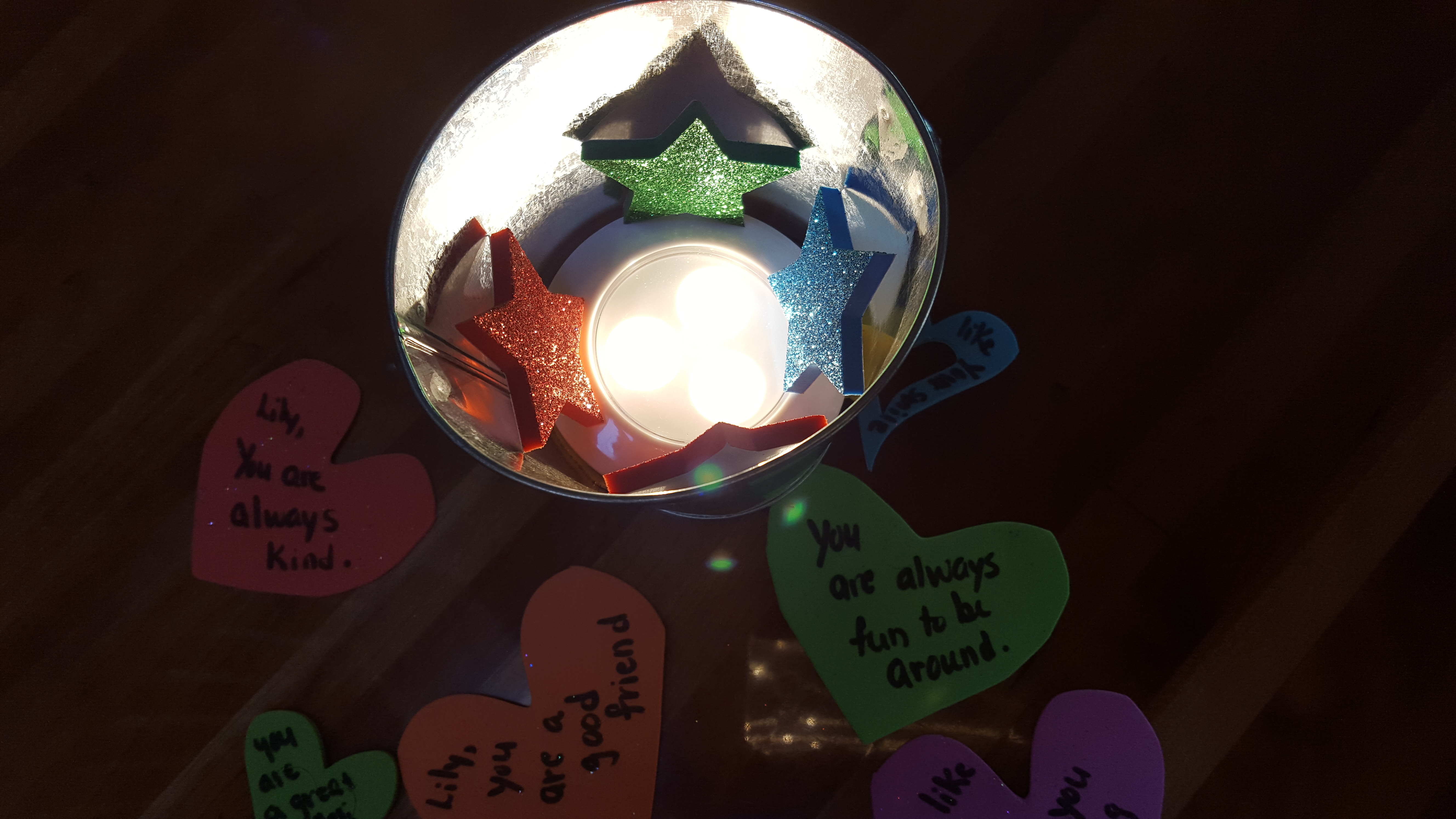
Definition
The quality of following the rules and laws of school, community, country, and world.
Literacy
Just a Dream by Chris Van Allsburg
Materials Needed
An energy light ball (can be purchased for $10.00 at scientificsonline.com)
Activity: The Circle of Citizenship
Citizenship is a sense of “shared responsibility” for the common good. We often don't realize all the different parts that are played by community members to make our community “work”.
Have the participants make a circle and hold hands. Use the “light ball” and show how it lights up when the circle is connected and goes out when the circle is disconnected. Note that each member of the circle is unique: we all look different, wear different clothes, and have different talents and gifts to offer the group. The circle needs each one of us to bring our special offerings to the group for it to be complete.
Make a list with students of the many things that people do in your town that make it work so well: Volunteer ambulance corps, librarians, volunteer tutors at the high school, homeless shelter, mailman/woman, utility workers (electric power), Red Cross, garbage (sanitation) collectors, road repair crews, nurses, etc.
Ideas From Our Workshops
Red Grammer and Maria Knickerbocker have been giving workshops at education conferences for over 20 years. The ideas below have been collected from teachers and parents just like you or created up by our “braintrust” at Red Note Records (which features two former teachers).
Click on the song titles for activities.
Click on the CD cover photo to purchase a CD.
Inspiration from the Music
A Chance for All to Become Inspired
The Grammer's music not only teaches us about community awareness, problem solving, and cultural uniqueness, it is fun, uplifting and it allows us to be who we are. It inspires movement, art, stories, quiet times. It gives teachers and parents inspiration to begin again. That's what the workshop is all about – a chance to become inspired by the words, the music and the incredible tenor voice of Red Grammer.“The joy of physical movement is the sparkling common thread among dozens of ways to enliven children's learning” (Mimi Brodsky Chenfeld).
Rhythm Training and Physical Awareness
Rhythmic and repetitious movement activities allow children to develop body coordination, and an increased ability to sense the beat and rhythm of their experiences. Most music programs recognize the need for physical awareness of music and include movement. Rhythm training through movement, which is then applied to the instrument, can be very effective for both beginners and for students who are more advanced. Kinetic experiences link music concepts with physical sensation to clarify relationships between musical ideas. Movement and body awareness is part of the learning process, to not only build left brain dominance, but to integrate the right brain into every experience. There have been many studies that show that exercise makes learning easier as unnecessary stress is eliminated.
Switching ON the Brain
This workshop will show simple rhythmic and repetitious movements to go with a variety of Red's songs that can be used to “switch on the brain”. Typically, children learn to read by first being taught letters, then part of words, then complete words, and finally sentences. This must be true for physical education as well. Before children can be taught games or dances they must first know the 8 basic locomotor skills – walking, running, hopping, skipping, galloping, sliding, jumping, and leaping. children will have lots of opportunities as they grow to learn games and dances but first they must learn the basic skills needed for successful participation. (This information and more can be found in Children Moving: A Reflective Approach to Teaching Physical Education, Third Addition by George Graham, Shirley Holt/Hale and Melissa Parker).
It Comes Naturally
For many children these movements come naturally. A fun way to assess what skills a child has mastered is to play or sing “The Barnyard Boogie” while the children move in a circle. Like in a square dance, call out which skills you would like the child to perform in a circle. To add to the fun, do the Macarena movements during the chorus. For a greater challenge you can combine some of the skills (ex. 2 hops and 1 jump and then repeat).
As children become ready, they begin to combine skill themes and form movements that we call gymnastics, or dance. During this workshop we are going to share with you some ideas about moving with music that will include dance, improvisations, and simple hand gestures.

Conflict Resolution can be learned when we are small and can positively affect our families, our friendships, our classrooms, and our world. In addition to the many songs that Red sings about having an caring and accepting orientation to the world he has a number of songs that were specifically created to help children confront conflict constructively and develop the self control and the listening skills that can defuse misunderstandings and problems before they become serious.
Below you can see Red’s “Conflict Resolution” related songs by album and theme. Click on the album title to purchase the CD. Some song titles link to activity lessons for that song.
Teaching Peace
“One of the top five children’s recordings of all time” All Music Guide
Parents’ Choice “Classic” Award
Use A Word — Constructive Expression, Words not fists
See Me Beautiful — Looking Beyond Oneself
Shake Your Brains — Creative Problem Solving
Hello World
Parents’ Choice Gold Award, USA Today “Kid Pick”
When I Get A Feeling — Learning the Language of Feelings
I Want You To Listen — Active Listening Skills
Bebop Your Best!
2005 Grammy nominee “Best Musical Recording for Children”
The following songs could be used to explore ways to prevent conflicts from starting:
Truthfulness
Fairness
Trustworthiness
Respect
Patience
A Line Dance
Line dancing is popular at all age levels. Both boys and girls enjoy this type of dancing and are equally enthusiastic about participating. They especially enjoy this dance when the teacher participates as well. Try having the children wear cowboy hats and red bandannas!
Music: Digging for Diamonds from Red Grammer's recording Hello World!
Origin of steps:Dr. Grant Longley, Dance Instructor, Venice, FL.
Position: Solo, all facing head of Hall
Intro: Wait 8 count
Measures:
|
1m |
TOUCH R TOE TO SIDE |
Point right toe to right side. Touch right toe beside left foot. Point R T to R side, step right foot beside LF. |
|
2m |
TOUCH L TOE TO SIDE |
Point L Toe to L side, touch L beside RF, point LT to L side. Step LF beside RF. |
|
3m |
R HEEL FWD. TOE REAR |
Touch R Heel fwd., HOLD, touch RT to Rear, HOLD. |
|
4m |
R HEEL FWD. STEP |
Touch RH fwd., HOLD, step RF in place, HOLD. |
|
5m |
L HEEL FWD. TOE REAR |
Touch LH fwd., HOLD, step LF in place, HOLD. |
|
6m |
L HEEL FWD. STEP |
Touch LH fwd., HOLD, step LF in place, HOLD. |
|
7m |
R TOE SIDE REAR, Cross Ramble |
Extend RT to R side/rear, step RF XIF LF, extend L foot to left side at the same time make a 1/2 turn right; (now facing right hand wall). |
|
8m |
BACK UP FOUR |
Walk backward RF, LF, RF, LF clapping on 4th beat. |
With a little practice children from 4 years old and up can do this dance. If you feel that a low impact level would be more appropriate for your class, a variation to the dance is followed:
|
1m |
TOUCH R TOE TO SIDE |
Point right toe to right side. Touch right toe beside left foot. Point R T to R side, step right foot beside LF. |
|
2m |
TOUCH L TOE TO SIDE |
Point L Toe to L side. Touch L beside RF,point LT to L side. Step LF beside RF. |
|
3m |
R HEEL FWD. TOE REAR |
Touch R Heel fwd., HOLD, touch RT to Rear, HOLD. |
|
4m |
R HEEL FWD. STEP |
Touch RH fwd., HOLD, step RF in place, HOLD. |
|
5m |
L HEEL FWD. TOE REAR |
Touch LH fwd., HOLD, step LF in place, HOLD. |
|
6m |
L HEEL FWD. STEP |
Touch LH fwd., HOLD, step LF in place, HOLD. |
|
7m |
R STEP FWD., LEFT STEP QUARTER TURN |
With the right foot step forward then swing your left foot around for 1/2 turn. |
|
8m |
BACK UP FOUR |
Walk backward RF, LF, RF, LF clapping on 4th beat. |
Class Photo Album
The following are directions to make a delightful decorated classroom photo album based on the song down the do re mi, that students will love to have the opportunity to take home overnight and share with their parents.
Materials
One scrapbook
Acid free paper the right size for the scrapbook
Attached tracers (Tracer1 Tracer2)
The words to Down the Do Re Mi in large print for a big book. We made ours with the computer.
Red Grammer's recording, Down the Do Re Mi
Scissors
Markers
Stickers
Glue stick
Pictures of your students
Thin black string for staff
A picture of the world (many colorful pictures of the world can be found on holiday greeting cards)
Pages to Make
Page 1 and 2 are side by side. Use blue background paper and add birds and sun.
Page 3 the children are sliding down a ray of sun.
Page 4 is a picture of the world with a staff drawn around the world. Put notes on the staff and the children's pictures in the notes.
Page 5 is a repeat of Page 3 but you can use different pictures of the children.
Page 6 is two large notes with a + sign and then a drum. Children's pictures go on notes and drum.
Page 7 is a staff made of string and notes made to fit on the staff. Attach the notes with clothes pins. Kids pictures go on the notes.
Page 8 are hearts floating on the clouds. Kids pictures go on the hearts.
Page 9 is a repeat of age 3.
Page 10 is a family watching a heart balloon float through the air. Pictures go on the family and the heart.
Page 11 is a boy and girl singing in harmony.
Page 12 and 13 is a repeat of Pages 1 and 2.
Page 14 is a repeat of Page 3.
You can be creative and add flowers, stickers, etc. to make your pictures more colorful. This is a big book that the children can take home and read to their families and share pictures of their classmates.
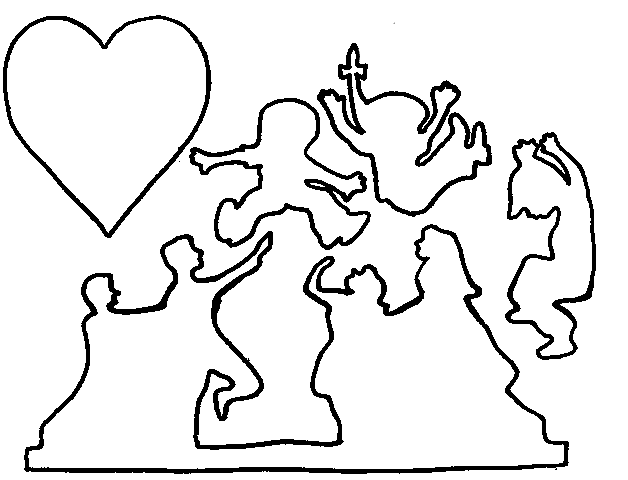 Tracer 1 – Print this page & cut out tracers
Tracer 1 – Print this page & cut out tracers Tracer 2 – Print this page & cut out tracers
Tracer 2 – Print this page & cut out tracers
The average human being sleeps a total of 24 years of a lifetime! That's a lot of nap time! “Dreamtime Rendezvous” is a wonderful song that can be used especially at nap time in your classroom.
Materials
1. The song “Dreamtime Rendezvous” from Red Grammer's recording, Down the Do Re Mi
2. The following books for classroom reading and class discussion:
Animals Asleep by Sneed B. Collard (2004 Houghton Mifflin Co., Boston)
Sleepy Book by Charlotte Zolotow (1986 Harper Collins)
Animals Don't Wear Pajamas by Eve B. Feldman (1992 Henry Holt & Co., New York)
Animals At Night by Sharon Peters (1983 Troll Assoc.)
A Time For Sleeping by Ron Hirschi (1993 Cobble Hill Books, New York)
3. Plain paper for children to draw on
4. CD player
5. On the last day of this lesson students can bring in their favorite animal to sleep with.
Objectives
1. A student can state that people and animals need to rest in order to stay healthy
2. A student will become aware that animals sleep in different positions and in different locations (i.e. dens, caves, rocks, water, and trees)
3. Students can demonstrate by acting out or drawing the way animal(s) may sleep that has been mentioned in the lesson
Lesson
1. Play the song “Dreamtime Rendezvous.”
2. Discuss how the family was sleeping all in a row, how we sleep in rows in our classroom and other times we might sleep in groups or in a row (firefighters at the fire house; sleeping with your family in a tent).
3. Discuss how we sleep in our pajamas and in our beds or on a couch.
4. Read Animals Sleep to show how animals also need sleep and that sometimes some animals can sleep in unusual ways.
5. Play “Dreamtime Rendezvous” while students are napping.
6. Repeat steps 1-5 on different days and on step 4 choose a different book each day that is mentioned in materials of this lesson.
7. Have students act out or demonstrate the way some of the animals they learned about sleep.
8. Have students either draw themselves sleeping with one of the animals or color a picture of one of the animals that was mentioned during the lesson. The attached pictures may be used.
9. Conclude the lesson by having the students come together with their stuffed animals that they brought to school and have them sing “Dreamtime Rendezvous” while “napping” with their stuffed animal.
List of animals that sleep in unusual ways:
1. A horse sleeps standing up
2. An orangutan likes to weave a nest of branches in the trees for a nice nap
3. Mother pandas often curl up to nap with their babies
4. Otters like to wrap themselves up in seaweed - the kelp keeps sea otters anchored in place while they are sleeping
5. Bird experts believe that sooty terns sleep or doze in midair as they slowly flap their wings
6. Butterflies often gather together at night to roost
7. Dogs seem to sleep in almost any position you can think of
8. Bats sleep upside down
9. A parrotfish surrounds itself with a mucus “sleeping bag” before going to sleep
10. A bottlenose dolphin can put half of its brain to sleep at a time - while half of the brain rests, the other half lets the dolphin slowly swim
11. Seals sleep with their flippers flat against blocks of ice
12. The snowy crane sleeps standing up on one long leg
13. Turtles sleep inside their shell
14. Caterpillars sleep in their silky cacoons
15. Spiders when they sleep are like small ink spots in the middle of their web
16. Opossums sleep upside down from the branch of a tree
17. Owls sleep during the day
Red Grammer’s music is beloved by educators around the world. His playful, uplifting recordings communicate themes of caring, excellence, oneness, and character in songs that kids eagerly embrace and instantly understand. He is a frequent keynote presenter at national and regional educational conferences across the U.S. and Canada.
“Powerful, funny, moving— each song is a lighthouse guiding us on our way. Hooray for Red Grammer!” Dr. Michele Borba, author of Building Moral Intelligence
“ ‘Bebop Your Best!’ is one of the most dynamic, lively, enjoyable, and beautifully orchestrated albums of children’s music on character building ever!!” Linda Kavelin Popov, Founder, The Virtues Project
“Red Grammer is truly a delight to listen to but more importantly he is a man with a message for students, staff, and parents. Our classroom teachers and our music teacher use his music as an integral part of our comprehensive character education program.” Rich Parisi, Principal, Morgan Road Elem. School,
National School of Character Winner (2000) Liverpool, New York
“Red's music is a perfect way to integrate the arts with the peace building messages we use in our schools.” Candy Reed, School Counselor, Davenport, Iowa
“His beautiful voice, his thoughtful lyrics, his enthusiastic smile, his interaction with the students, and his genuine love for the children of the world warmed our hearts.” Principal, San Leandro, California
“Red Grammer is a treasure & a gift! His visit to my school set a positive & unified tone for the whole year. My entire school, parents included, cannot give Red enough accolades and eagerly anticipate his return!” Georgia Polak, Music Teacher, Kamuela, Hawaii
“My kids love your music and the themes go so well with the values we are trying to teach.” Lynda Courage, 1st Grade Teacher, NY
“I can’t think of a better way to enhance the things we already teach our students about tolerance, acceptance, and respect than through your music. Hooray for Red Grammer and the message he spreads!” Candi Lynch, Elementary School Counselor, IA
“Thank you for providing early childhood educators with such wonderful songs of joy, peace, and hope to share with our classes every day.” Michelle Arant, Pre-K teacher, CA
“Thanks to you and Kathy for using your talent for those of us working with young children. The uplifting beats and rhythms and the positive messages have blessed and enriched my Family Child Care Program so much. Thank you.” Dawn Schell, Family Child Care Professional, NY
Every Teacher's Best Friend - MUSIC!
Red Grammer

This page is a recap of the ideas, songs and activities covered in the presentation. The links in red will take you to each song's lyric page that features an audio player of the song, videos showing the sign language when available, and links to the song's accompanying activities. Have fun!
Music has an amazing power to:
Inspire
Uplift
Recharge
Give Us A Sense of Belonging
“Group music-making or singing together may result in social bonding, which may be explained by the release of the neuro-transmitters endorphin and oxytocin .”
(e.g., Dunbar, Kaskatis, MacDonald, & Barra, 2012; Freeman, 2000; Tarr et al., 2014; Weinstein, Launay, Pearce, Dunbar, & Stewart, 2016)
& Reduce Stress
“Music seems to be able to decrease physiological arousal, which is increased during stress.
Music listening, and music making/singing, have been associated with decreases of physiological arousal, shown by reduction of cortisol levels or decrease in heart rate and blood pressure.”
(Hodges, 2011; Koelsch et al., 2016; Kreutz, Murcia, & Bongard, 2012; Leardi et al., 2007; Linnemann, Ditzen, Strahler, Doerr, & Nater, 2015; Nilsson, 2009; Sokhadze, 2007).
“Music may also affect stress-related emotional states, such as subjective worry, anxiety, restlessness or nervousness.”
(Akin & Iskender, 2011; Cohen et al., 1983; Pittman & Kridli, 2011; Pritchard, 2009)
“This is because music can modulate activity in brain structures that are known to be crucially involved in emotional processes…
Recent neuroimaging studies on music and emotion showed that music may strongly influence the amygdala, a part of the limbic system, which is a section of the brain that plays a crucial role in the regulation of emotional processes by releasing endorphins.”
Arts and the Brain
We all know how the arts touch us and move us, but there is also a lot going on neurologically in our brains when we expose ourselves to the arts that has implications for learning. The arts simultaneously develop and mature multiple brain systems:
Sensory
Attentional
Cognitive
Emotional
Motor Capacities
(from Arts With the Brain In Mind, Eric Jensen)
Research with the Harmony Project in Los Angeles has shown how learning an musical instrument improves the brain's ability to process pitch, timing and timbre, which in turn improves students' processing of consonants and vowels. This gives them a better ear for speech.
The following heatmaps of brainwaves show how music lessons improved kids' neurophysiological distinction of consonants.
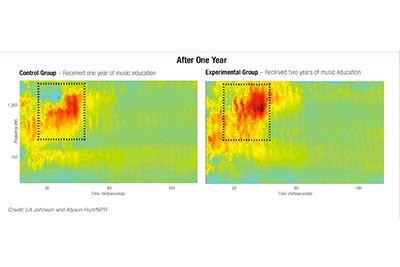
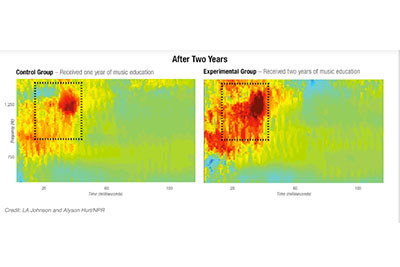
Credit: LA Johnson and Alyson Hurt/NPR
Harness The Power Of Music to:
- Set the Tone of Your Classroom
- Build Classroom and School Community
- Enrich Curricula
- Bring Positivity and Good Energy
- Help Children Face Fears, Manage Transitions & Build Joy
- Relax
- Deepen Relationships with Parents
Set The Tone of Your Classroom
We are kind...
We use words, not fists...
We look for the best in everyone...
We are proud of each one of us...
Build Classroom Community
There's a place for everyone...
There's a place for Everyone...
There's a place for EVERYONE...
Cooperative work...
Who we are...
Bucket Fillers, That's Who We Are
Birthdays...
Enrich Curricula
It's all about CONTEXT!
When presenting new material songs can provide powerful contextual connections that help students better retain new information.
Example:
If, when working on the letter “B” in class, students are singing the song “Bingo” and holding up a letter “B” each time it is sung they will be growing extra neurological connections to their relationship to the letter.
Help Challenged Readers
Rhythm and melody are powerful hooks that make lyrical text more “sticky”.
When learning new words or sounds, have your child “sing” the material using different musical styles.
When learning new words have children tap their foot or snap their fingers.
For larger words have students segment the word by syllables, hitting their palm in their fist in rhythm.
Sing your sentences!
Give your child the lyrics to their favorite songs and have them read and sing along.
“Fluffing” - Doing hand and arm motions that cross the center line helps students build important neural pathways that help reading
Build Vocabulary
Using songs is a great way to introduce new vocabulary.
The emotional and narrative context of a song helps reinforce the learning of the meaning of the words while the catchiness of the song draws all children into a positive reading experience.
Bring Positivity & Good Energy...
Inspire, Enchant, Nurture
Inspire
Enchant
Nurture Self-knowledge
Face Fears, Manage Transitions and Build Joy
Courage and Resilience
Manage Transitions
Musical transitions can give a boost to classroom energy and reinvigorate students’ attention.
They can also help your class shift gears on a dime.
Teaching Peace (a march)
Build Joy
Group silliness adds valuable social glue to your classroom community
Relax
Deepen Relationships w Parents
See Me Beautiful Slide Show
Collect pictures of your students and create a slide show that plays with the song, "See Me Beautiful".
When you present this at an open house EVERY parent will be touched. Click on the picture below to see a stunning video put together by a professional photographer with pictures and this song.
I Think You're Wonderful Activity
Kraft Paper Kids - Instructions

ANYONE can use music to enhance the spirit, the energy, the focus and the happiness of their classroom.
Yes, that means you! :0)
Every Teacher's Best Friend - MUSIC!
Red Grammer

This page is a recap of the ideas, songs and activities covered in the workshop. The links in red will take you to each song's lyric page that features an audio player of the song, videos showing the sign language when available, and links to the song's accompanying activities. Have fun!
Arts and the Brain
We all know how the arts touch us and move us, but there is also a lot going on neurologically in our brains when we expose ourselves to the arts that has implications for learning. The arts simultaneously develop and mature multiple brain systems:
Sensory
Attentional
Cognitive
Emotional
Motor Capacities
(from Arts With the Brain In Mind, Eric Jensen)
Research with the Harmony Project in Los Angeles has shown how learning an musical instrument improves the brain's ability to process pitch, timing and timbre, which in turn improves students' processing of consonants and vowels. This gives them a better ear for speech.
The following heatmaps of brainwaves show how music lessons improved kids' neurophysiological distinction of consonants.
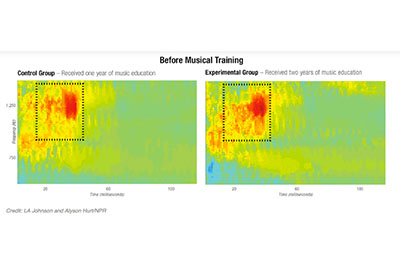


Credit: LA Johnson and Alyson Hurt/NPR
Harness The Power Of Music to:
Set The Tone of Your Classroom
We are kind...
We use words, not fists...
We look for the best in everyone...
We are proud of each one of us...
Build Classroom Community
Cooperative work...
There's a place for everyone...
Who we are...
Bucket Fillers, That's Who We Are
Birthdays...
Enrich Curricula
It's all about CONTEXT!
When presenting new material
songs can provide powerful contextual connections
that help students better retain new information.
Example:
If, when working on the letter “B” in class,
students are singing the song “Bingo”
and holding up a letter “B” each time it is sung
they will be growing extra neurological
connections to their relationship to the letter.
Help Challenged Readers
Rhythm and melody are powerful hooks that make lyrical text more “sticky”.
When learning new words or sounds, have your child “sing” the material using different musical styles
When learning new words have children tap their foot or snap their fingers
For larger words have students segment the word by syllables, hitting their palm in their fist in rhythm.
Sing your sentences!
Give your child the lyrics to their favorite songs and have them read and sing along
“Fluffing” - Doing hand and arm motions that cross the center line helps students build important neural pathways that help reading
Build Vocabulary
Using songs is a great way to introduce new vocabulary.
The emotional and narrative context of a song helps reinforce the learning of the meaning of the words while the catchiness of the song draws all children into a positive reading experience.
Inspire, Enchant, Nurture
Inspire
Enchant
Nurture Self-knowledge
Face Fears, Manage Transitions and Build Joy
Courage and Resilience
Manage Transitions
Musical transitions can give a boost to classroom energy and reinvigorate students’ attention.
They can also help your class shift gears on a dime.
Teaching Peace (a march)
Build Joy
Group silliness adds valuable social glue to your classroom community
Relax
Deepen Relationships w Parents
See Me Beautiful Slide Show
Collect pictures of your students and create a slide show that plays with the song, "See Me Beautiful".
When you present this at an open house EVERY parent will be touched. Click on the picture below to see a stunning video put together with pictures and this song.
I Think You're Wonderful Activity
Kraft Paper Kids - Instructions

ANYONE can use music to enhance the spirit, the energy, the focus and the happiness of their classroom.
Yes, that means you! :0)
Everybody Here Has A Bucket!

This page is a recap of the ideas, songs and activities covered in the Red's presentation. The links in red will take you to each song's lyric page that features an audio player of the song, videos showing the sign language when available, and links to the song's accompanying activities. Have fun!
Power To Change The World (Sign Language)
History of Bucketfilling

Donald O. Clifton
The Bucketfilling model was conceived by Dr. Donald O. Clifton. In his research into why US POWs in the Korean War had the highest mortality rate of any war despite a lack of unusual physical abuse he discovered that it was the N. Koreans' intentional breaking down and destruction of the human connections between the US prisoners that caused them to give up and die. In thinking about the dire consequences of this kind of dismantling of support and caring he began to investigate its opposite. What would happen if time and energy and care were given to building connections between people. This began his life's work which has led him to be called the Father of Positive Psychology.
From his work he developed the concept of everyone having an invisible "bucket" inside of them that holds all their good feelings about themselves. When our bucket is full we are happy and everything seems possible. When it is empty we are sad and depressed and defeated.
Carol McCloud

Early childhood educator, Carol McCloud, found this model to be a simple and effective way to develop and support the pro-social behaviors and interactions with her students. Sensing a need she wrote the best-selling picture book, "Have You Filled A Bucket Today?" which brought bucketfilling to early childhood and elementary education.

There are three rules of bucketfilling:
Bucket Filling Rule #1: Fill Other's Buckets
Fill A Bucket (Round)
Bucket Filling Rule #2: Don't Dip
Help children distinguish between bucket filling and bucket dipping by playing "Thumbs Up/Thumbs Down" with various scenarios.


Bucket Filling Rule #3: Use Your Lid
Bucket filling and bucket dipping are both contagious.


When we use our lid we stop the "dipping energy" and change the outcome.

Fill EVERYONE'S bucket:
Introvert, extrovert, happy, sad, easy, difficult
"5 Minute Rule" - When you meet someone give them 5 minutes of kindness, caring, love, and safety. If you do they will usually begin to show up with their true, wonderful self.
Creating A Bucketfilling Environment With Songs, Stories and Service
Bucketfilling Songs For Kindness and Empathy
See Me Beautiful (Sign Language)
Kraft Paper Kids - Instructions

"See Me Beautiful" Glasses

I Think You're Wonderful (Sign Language and Coupon)

Bucket Filling All The World Around
Rapp Song (Tootsie Roll Pops) - "We all look different, but we're all the same."

Teaching Peace (Sign Language, Spiral March)
Bucket Filling For The Planet
Fill My Bucket With Fun
These are great songs to use to hit the "reset" button in your classroom and have a collective experience of fun.
Barnyard Boogie (Rooster Hats, Clucking Cups)


Down By The Sea (Motions, Make Up New Verses)
Building A Bucket Filling Identity and Culture
Songs and art
Everybody Here Has A Bucket (Bucket Hat)
Bucket Fillers, That's Who We Are (March, buttons and signs)
Click on images for pdf templates of buttons and signs


I Am A Bucket Filler (Videos, bracelet)

Circle of Light ("Bucket of Light" Circle Time, Energy Ball)


Stories
Sharing your own bucketfilling experiences with the children is a powerful way for them to connect to the ideas involved.
Red's Story w Kyle Crabb
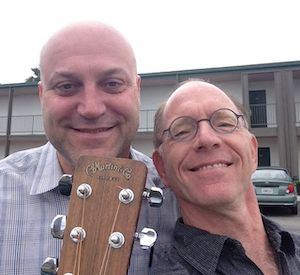
Service
Doing classroom service projects in the context of bucketfilling helps the meaning of the activity become more concrete to young students.
In Closing...
Here are Carol McCloud's words to every group of students she meets:
"Do you want to have the happiest year of your life? Be a bucket filler!"
Motions for Everybody Here Has a Bucket
Everybody here has a bucket (Yes)...with closed fist, lift one hand up slightly form your waist like you are lifting the handle of a bucket, or pail of milk. http://www.babysignlanguage.com/dictionary/b/bucket/ On the word "yes" raise a fisted hand over your head and shake hand once (like you are knocking on a door) http://www.babysignlanguage.com/dictionary/y/yes/
Everybody's bucket holds light (Right)...use the bucket motion like above again. For "right" with close fist raise your hand from waist to front of you (people also use this hand motion when shouting hurray only it is a lower cut instead of an upper cut)
Add a little light here and a little light there...hands extend across your body and wiggle your fingers for "here". Do it in the opposite direction for "there".
Till everybody's bucket shines bright...Turn in a circle to the beat of the music and on the word "bright" start with hands at your side begin to raise them up and over your head, hands open. Make sure your hands cross in front of you when they get to about your waist on your way up over your head. They should be uncrossed by the time you get to the top and fingers wiggling.
We get it going with... this line goes by quickly and you need to be bringing your hands back down to your side form the previous step so it looks like you have made a circle with both your hands when these 2 steps are complete.
With a helping hand...look like you are shaking your one hand in front of your chest to someone who is not there.
Here I Am...Look like you are raising your hand to answer a question in the classroom.
It's so easy...step side to side to the beat of the music.
The other motions are:
With a friendly look...Point to your eyes with your index finger and middle finger in a v formation and then point them out http://www.babysignlanguage.com/dictionary/l/look_at/
That's all it took.... hands are palms up, wrists are bent backwards and arms are out to your side with elbows bent and close to your waist
With a big hello...like hello in sign language with right hand in an open position moving outward from the forehead, almost as if saluting http://www.babysignlanguage.com/dictionary/h/hello/
What do you know...with one hand the index finger touches the temple and then moves out (like you motion, "ah-ha")
Make a friend...sign language for friend by hooking the right index finger over the left which is palm-up and repeat in reverse http://www.babysignlanguage.com/dictionary/f/friend/
Come on in... use one hand like you are waving for someone to come to you.


Bucket Hat
This activity is designed to help children recognize and understand that everyone has a bucket. It helps them to focus on others instead of themselves. It is easy to fill our friend's bucket, but what about a person we don't often play with or know very well? What if we get a new student in the classroom?
For Younger Students
Materials:
Construction paper long enough to fit around a student's head (roughly 23" long x 5 " high)
The pattern for the bucket (see below)
Markers, glitter, crayons, or paint to decorate construction paper and bucket
Activity:
Play the song, "Everybody Here Has a Bucket".
Give each student long construction paper and have them draw stars and hearts to decorate on the one side. Remind them that they are making hearts and stars because they are the symbols used for filling a bucket.
Give each student a copy of the pattern for the bucket and have them fill the bucket with hearts and stars. Then have them write thier name on their bucket. *See below for more ideas about name writing.
Glue bucket in the middle of the long construction paper. Wrap the long construction paper around the student's head so it fits snug and staple the two ends together (just like making a birthday crown).
Students wear their crown with attached bucket for the day so that others may see their bucket and yet they are not looking at their own bucket that is on their head.
While students are still wearing their bucket crowns, play the song again and teach students the motions to go along with the songs.
*Have students write their name on their bucket with glow in the dark paint. Hold the painted name under a lamp light for about 30 seconds to a minute. Once everyone is wearing their bucket crown, play the song, "Everybody Here Has a Bucket" and when the second line is sung, "Everybody's bucket shines bright", switch the light off so that their names glow and continue to play the song. You can do the motions to the song during this time.
For Older Students
Materials:
Have student's bring in a cloth headband (sweatband).
Tongue depressors
The pattern for the bucket (see below)
Tape
Activity:
Play the song, "Everybody Here Has A Bucket".
Have each student pick or draw a name from a class list. It should not be their name.
Give each student the pattern for the bucket.
Using glitter, markers, etc., decorate the bucket filling it with hearts and stars. Then write the student's name that they were assigned on the bucket.
Underneath that person's name they should write a word or a few words that describes that person. Examples: "always happy" "caring" "kind' "strong artist" excellent mathematician" "helpful"
Tape the bucket to the top of a tongue depressor.
Have all students put their headbands on.
Each student should then slip the tongue depressor with the bucket into the headband of the student whose name they were assigned, without that student seeing what was written about him/her.
Every student must then guess what was written about them by going around and asking other students for clues. When giving clues you cannot say the word or words that are written on the bucket. Describe the word without saying the word. Two things are happening, the students are trying to find out what was written on the bucket about them and they must think of clues for the other students around them. It is nice to find out what other people think of you and fun to help out your friends.


Definition
The quality of being just, upright, and honest; showing no favoritism or prejudice.
Literacy
1. The story The Little Red Hen by Jan Brett
2. The story The Little Red Hen Makes a Pizza by Philemon Sturges
Materials Needed
The song, “Fairness”, from the recording, Bebop Your Best
Read the original story, the Little Red Hen, and have a discussion about who and what was fair in the story.
Activity:
Bring a pan of brownies or some cans of play dough to the class. Tell the class that there are not enough for the whole class so not everyone will get some. When the students say that it is not fair (don't worry, it will happen) then ask the class what could be done to make it fair. This could turn into a great math lesson to figure out how they are going to divide the goodies so everyone gets a fair share!
Follow up this activity by reading The Little Red Hen Makes a Pizza
Play sing and teach the song, Fairness to the class. Be sure to go over with the students the vocabulary and the expressions that are included in the song (Ex. “The truth will come to light” and the “answer is right before your eyes”).
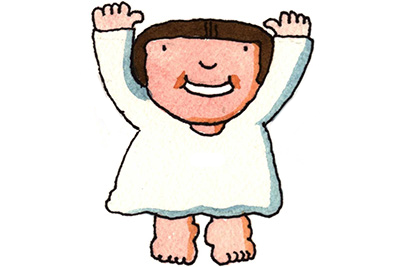
For Positive Behaviors
Red's music has been written to playfully connect with the best in every child and to encourage positive interactions with the world around them. Let the following songs help you set classroom expectations and make it easy and fun for your children to embrace and internalize them:
Friendliness/Kindness
Respect
Responsibility
Cooperation
Appreciation of Others
Excellence
Honesty/Trustworthiness
Caring and Compassion
Conflict Resolution
Courtesy
Appreciating Diversity
We're Rich
Self Knowledge
Building Community
Empowerment/Hope
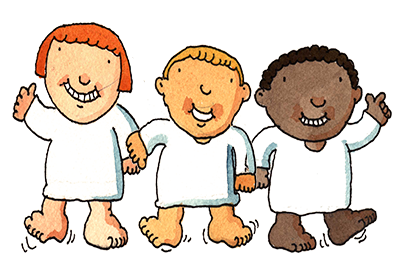
Fun and Silly Songs
Every classroom needs joy and laughter in the daily mix to keep children present in the moment and alive to the exciting process of learning new things. Here are some great Red Grammer songs to use when you need a “brain break” with your students...
Down By The Sea - comes with fun motions! (video)
Hello World - learn the sign language! (video)
Barnyard Boogie - do the clucking! (video)
Hooray For The World - (video)
Can You Sound Just Like Me? - (video)
Tickle Song -(video)
Materials Needed
“Grand Old Flag” from the recording, Red Grammer's Favorite Sing Along Songs
To make one flag banner you will need:
Wire edged ribbon with a flag design on it that is at least 2 ½” wide and 20” long
Blue cord for handle, 17” long
White tassel
How to make a Flag Banner
(Picture at bottom of lesson.)
Lay out the 20” wire edged ribbon so the backside is facing up. At the half way mark of the ribbon, place the ends of the blue cord so that they overlap. Glue the ends of the cord together and glue it to the back of the ribbon. Now fold the ribbon in half so that the glued part of the cord is no longer visible and you see the design side of the ribbon. Lay the white tassel near the end of the ribbon (the opposite end of where the blue cord is). Glue the tassel down to the ribbon. Now fold the corners of the ribbon over the tassel and glue down. This becomes the back of your flag banner.
Students can do the following movements to the song “Grand Old Flag” holding the banner by the blue cord:
(Children are standing in a straight line. They are holding the flag banners in their right hand, down by their waist.)
“It's a grand old flag”
On the word “grand” the kids move the banner forward and away from their body.
“It's a high flying flag”
On the word “high” the kids move the banner up into the air, over their heads, with their arms straight up.
“And forever in peace may she wave”
While the banner is still up in the air, the kids move the banner left to right, back and forth.
“She's the emblem of the land I love” The kids march (and will continue to march in place till the end of the verse) in place while still waving the banner over their heads.
“The home of the free and the brave”
The kids cross arms in front of chest, and then extend hands outward and then to the sides.
“Every heart beats true for the red, white and blue”
The left hand goes back down to the side. The right hand brings the banner up to the chest and beats the heart.
“Where there’s never a boast or brag”
As hand continues to beat chest, shake heads no to show never a boast or brag.
“Should old acquaintance be forgot”
The children turn themselves in a circle.
“Keep your eye on the grand old flag”
The children raise the flag back up into the air and hold it there.
Repeat. At the end of the song, push the banner up as Red repeats “keep you're eye on the…” On the third time the kids leave the banner up in the air.
Variations
1. Instead of in a straight line, the children can be in a circle facing the outside of the circle. When it's time to march, the circle can move. When they get to “every heart beats true” the circle can stop and the students can march in place.
2. Older students would be able to do it in a circle facing the outside of the circle. Instead of moving the circle when the marching begins, have the students pass the banners around the circle. They can continue to do that until they get to “every heart beats true.”
There are many more things you can do with this lesson. For example, you can add a star to the flag banner that holds a picture of the student. They could take it home to use it as a doorknob decoration. You could display them on a bulletin board with the American flag included. Please keep in mind that there is a lot of flag etiquette for our national symbol. I thought of putting the banners or stars right on an American flag but that is not proper flag etiquette. (You should go to www.usflag.org/flag.etiquette.html to find all the standards of respect for our country's flag.)
While at the NAEYC in NYC, some wonderful teachers at our workshop displayed a flag made by student’s hand prints. They used red hand prints for the stripes and blue hand prints for the star area.

Materials Needed
1. A box of instant mash potatoes.
2. A gravy bowl or gravy ladle.
3. Three white poster boards that when cut into quarters you get 12 (14” x 11”) boards. You will need 11 of the (14” x 11”) boards.
4. The song, Gratitude, from Red Grammer's recording, Bebop Your Best.
5. Markers, a hole punch and yarn.
Teacher Preparation
1. At the end of the song, Gratitude, Red and children sing the word thank you in different languages (see list below). Write each thank you on the white board with one color marker (one on each board). Write the country origin underneath in a different color marker:
Thank you ( English)
Gracias (Spanish)
Danke (German)
Merci Beaucoup (French)
Arigato (Japanese)
Komawoyo (Korean)
Shukran (Arabic)
Salamat (Tagalog – Philippines)
Ngiyabonga ( Ndebele- Zimbabwe)
Kia Ora (Maori – New Zealand/Australia)
Thanks a lot
2. After writing the words on the white boards turn the board over and punch 2 holes (one on each end) at the bottom of the board. Put enough string through the holes so that the board will fit over a student’s head. Each student will be wearing one sign but it will hang on them backwards and upside down (in other words you can't read the sign while it is hanging on the front of the student). When it comes time in the song to show their sign the student will flip it up so that everyone can see what is written on the sign. The reason for a sign on each student is so that their hands are free to participate in the movements for the song and each student can easily raise the sign up when it is time.
3. When it is time for the students to actually sing the song to a visitor in your classroom, either have the CD queued to the last part of the song where the “thanks you” in different languages are sung or tape that part of the song and have it ready on a cassette.
Activity
This activity is designed to have students show gratitude to visitors that come to your classroom. If you have room mothers come in or a special reader for your class the students can thank them in a very special way. This lesson is set up for 10 students. You can easily adjust it to the number of students in your room by just adding more thank you signs.
1. The 10 students line up in two rows of 5 facing each other. The student at the front of line A has a box of instant mash potatoes in his/her hand and is closest to the guest in line A. The student in front of line B has a gravy boat or ladle in his/her hand and is closest to the guest. The signs are around their necks with the words facing away so that they cannot be seen. With the very young students it does not matter if the signs are in the same order that the thank you’s are sung on the recording. With older students you might want to put them in order. You will understand what order to put them in as you proceed through the steps to this lesson.
2. As the children sing, “If you pass me the mash potatoes”, line A sways away from the guest and stops on the word “me” then swings or sways toward the guest and stops on the word "potatoes”. The student with the box of potatoes hands it to the guest. Line B is standing still through this part but is singing along with line A.
3. As the children sing, “and remember to put the gravy on the side”, line B turns away from the guest (it doesn't matter how many times they spin or turn) with their hands over their heads. They spin away from the guest until the word “gravy” then spin toward the guest until the word “side”. On the word side everyone in line B motions with one hand like they are pouring gravy and the student with the gravy boat or ladle hands it to the guest. Line A is standing still but singing along with Line B.
4. As the children sing, “I’m so grateful, so incredible grateful” Line A and Line B are facing each other one on one and they shake hands first with their right hands and, still holding the right hands, extend their left hands and shake hands. Their arms should be in a crisscross as they are shaking hands.
5. As the children sing, “Thank you, thank you, thank you”, they face partners for the first Thank you and say thank you in sign language; they face anyone else in the line for the 2nd thank you and say thank you in sign language; they face the guest for the last thank you and say thank you in sign language. NOTE: The sign language for thank you is: right hand is open and finger tips are touching your chin. left hand is open and away from the chin about a foot or so. The right hand moves away from chin and gentle drops and hits the left hand.
6. Now turn on the queued music for the thank you signs. It first starts by playing marching music. The 2 students at the front of the line march in place (these are the students that handed the guest the ladle and box of potatoes). The other students march so that last student in each row comes forward and others follow so that they are now all in one straight line facing the guest. As the “thank you's” are being sung the students hold up their signs one by one all the way down the line. This is quick so younger students may not be able to sing with the recording and their signs may not be in the exact order but it doesn’t matter. The guest will see all the thank you cards and understand that the students have sung "thank you" in different languages.
Extension
1. You could have the students write the words “Thank you” and sign them on a small piece of paper. The notes could be put in the gravy boat so the guest will be able to have them. But be careful that the student “pouring” with the gravy boat during the song doesn’t tip it too much or they will dump out.
2. You could add a thank you treat to the gravy bowl for the guest to take with them.
3. This activity could be done at the end of a spring/winter concert, Mother’s Day, Grandparent's Day etc.
Materials:
1. brown construction paper
2. large white or yellow rolled paper
3. construction paper in fall colors
4. glue, scissors, markers or pencils
5. The song, Gratitude from the recording Bebop Your Best by Red Grammer.
Procedure:
1. Play the song Gratitude and have students listen for things to be grateful for.
2. Take the class for a walk and have students observe the trees in the neighborhood.
3. As a group have students tear brown paper and paste to white paper to form the trunk of a tree.
4. With help from the teacher or from a partner, trace hands on fall colored construction paper.
5. Have students draw or write what they are grateful for.
6. Glue or tape the hands ("leaves") to the tree trunk.
7. Play the song Grateful and have students sing along when the grateful tree is completed.
Materials:
The song, Headin' On Down to the Barn from Red Grammer's award-winning recording, Down the Do Re Mi
Click on Heading On Down to the Barn and it will bring you to another lesson for this song that includes glove puppets. The glove puppets may also be used for this movement lesson.
Motions:
|
First Verse: Long ago, I grew up on a farm |
Arch one hand in a rainbow form towards the back of you. |
|
Eight years old heading down to the barn |
Hold up 8 fingers then point thumb behind you. |
|
5 o’clock each and every day |
Slowly raise your left hand with 5 fingers stretched out. |
|
The animals knew I was on my way |
Right hand has first 2 fingers in an upside down V to be used like feet walking. Have the two fingers on the right hand walk down the left arm starting at the inside of elbow down to the finger tips. |
|
With some milk, some feed, and a bale of hay |
Reach down with your left hand like you’re lifting a heavy pail of milk. Still pretending you’re holding the pail of milk, reach down with your right hand and pretend you’re lifting a heavy bucket of feed. Then pretend to use a pitch fork to dig into the hay and throw it over your shoulder |
|
I always knew they were happy to see me |
Hands open on either corner of your mouth with a big smile. |
|
Chorus: The cat meowed |
Pulling pretend whiskers. |
|
The dog went, “woof” |
Hands are open and fingers are pressed together with palms facing out. Put them up by your head for dog ears. As you make the dog ear motion say, “woof” |
|
And the horse went, “phbbbbb” when he stomped his hoof |
Head down and shake it while saying, “phbbbb” and then stomp one foot. |
|
And the turkey gobble-gobbled |
Hands under your armpits like you are flapping your wings, just like in the chicken dance! |
|
And the cow went, “mooooo" |
Each hand has the first finger and thumb make an L shape (the right hand will have a backward L). Place your L shaped hands on top of your head to make cow horns*. At the same time your chin is down and raise your head up while saying “Mooo” |
|
And the itty-bitty baby went, “boo-hoo hoo” |
Pretend to cradle a baby in your arms and then rub underneath your eyes with a closed fist like you are rubbing away tears. |
|
‘Cause he was hungry, too! |
Rub your stomach. |
|
Second verse is the same as the first only hold up 9 fingers for “9 years old” |
|
|
Chorus: same as above |
|
|
Third verse: same as the first verse but the final line is “Hey Dad” they were happy to see me!” Then repeat chorus as above. |
Cup hands like a megaphone to show you are yelling “hey Dad” then point to yourself with a big smile. |
*Most domestic cows (yes, female cattle) have horns. Cattle that lack horns naturally are referred to as polled. In most breeds, this is a recessive trait. However, some breeds -- Polled Herefords, for example -- are naturally hornless. So why do you see so many cows without horns? The farmers remove the horns. This is a management technique; cows often live in crowded conditions. And it's also easier to get a cow's head into a stanchion for milking (the cow, not her head) if she has been de-horned.
Materials Needed
The song, Headin' On Down to the Barn, from Red Grammer's recording Down the Do Re Mi
A pair of gardening gloves which you can find at hardware stores and many craft stores
Felt
Jumbo box of craft pom poms – animal assortment
6 mm ½ round black beads for eyes (they usually come 50 count)
Miniature house collection milk bottle
Miniature house collection pail
Miniature baby bottle (found in craft stores in decorating cake section)Picture or drawing of a baby Picture or drawing of a small boy in farm overalls
Picture or drawing of a farmer
To make Glove Puppets:
1. On the right hand glove, use pom poms, felt, and ½ round black beads to make a cat, dog, horse, turkey, and cow as shown in the picture. Be sure to have all the animals on the back of the glove (back hand). The cat should be on the index finger, the dog on the middle finger, the horse on the ring finger, and the turkey on the pinkie. The cow goes on the thumb. I added a little bell around the cow's neck.
2. Still on the right hand glove, on the palm side glue the picture of the baby and the baby bottle.
3. On the back of the left hand glove, glue the picture of the farmer. On the palm side of the glove, glue onto the index finger the milk bottle, on the middle finger glue the pail, and on the ring finger glue two tiny gold pom poms glued together for the bail of hay. On the palm of the glove, glue the picture of the small boy in farm overalls.
Procedure
1. While playing the song “Headin' On Down to the Barn” you will use the glove puppets. You wear the gloves during this procedure. Start with both gloves behind your back. I usually sway back and forth while Red is singing the beginning of the song until the line “the animals knew I was on my way.” When Red starts to sing “some milk, some feed, and a bail of hay,” I raise my left glove in a fist, fingers facing the audience. When Red sings “some milk,” I raise the index finger. When Red sings, “some feed,” I raise my middle finger while keeping my index finger up. When Red sings “and a bail of hay,” up goes the ring finger as well. As Red sings “I always knew they were happy to see me,” I show the whole inside of the glove to show the small boy and I move my arm to show that the boy is moving down to the barn.
2. On the chorus, my left gloved hand goes behind my back. My right hand glove comes up in a fist with my fingers facing toward me and the back of my hand facing toward the audience. When Red sings, “when the cat meowed,” put the index finger with the cat up. When Red sings “and the dog went 'woof!'” put the middle finger with the dog up. When Red sings “and the horse went 'phbbbbbbb' and stomped his hoof” put the ring finger with the horse up and I usually stomp my foot as well. When Red sings “and the turkey gobble-gobbled,” put the pinkie with the turkey up. When Red sings “and the cow went 'moooo'” I give a big moo and show the cow.
3. As Red gets to “and the little bitty baby went boo-hoo-hoo,” I turn the right hand glove so the palm is facing out, showing the baby, and waving my hand left to right.
4. Repeat for the second verse and chorus.
5. On the last verse, I start with the farmer all grown up and then flip my glove to show the son eight years old on the palm. Repeat the rest as before.
6. After you've done this a couple of times, the kids can shout out the animals and the sounds that they make while you use the puppet gloves. Then I have kids take turns giving one child the left glove and another child the right glove.
7. Older kids could probably make their own puppets to use.
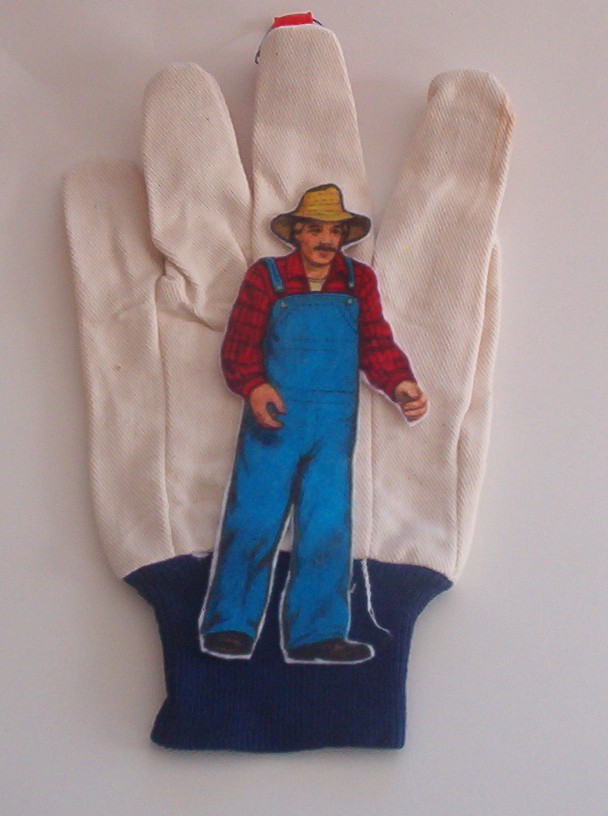

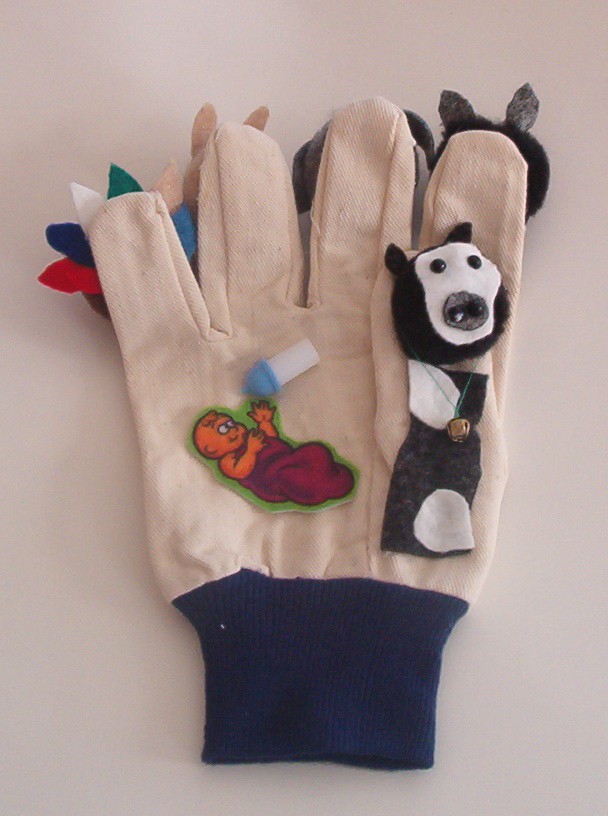
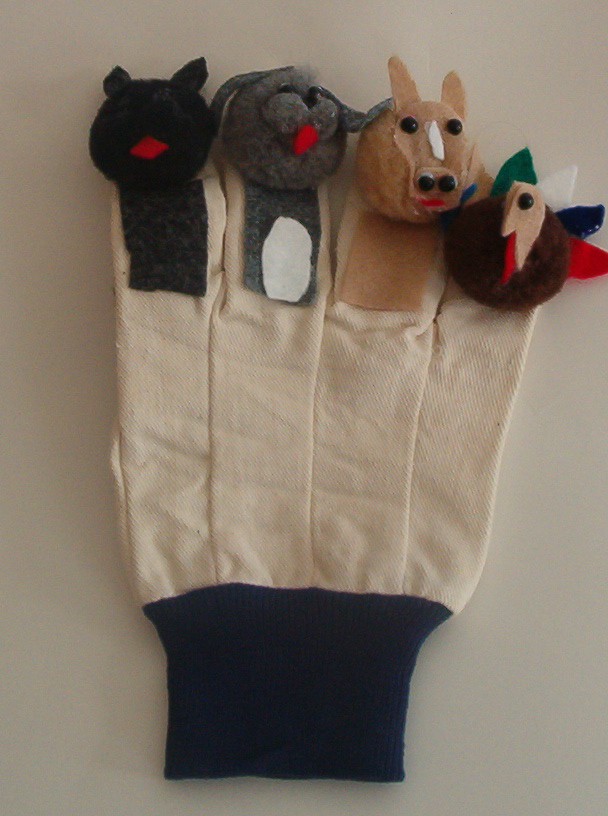
"Hello World" Workshop Handout

This page is a recap of the ideas, songs and activities covered in the workshop. The links in red will take you to each song's lyric page that features an audio player of the song, videos showing the sign language when available, and links to the song's accompanying activities. Have fun!
Place In The Choir Song
Where The World Is Going
Changing Demographics -
Second immigration wave lifts diversity to record high- COLLISION OF CULTURES, LANGUAGES AND POLITICS POSES PERILS AND PROMISES, USA TODAY, 2014, Greg Toppo and Paul Overberg

Amidst all this change we are walking around
with racial associations that can impede our best selves
from showing up in racially complicated situtations.
For a great Ted Talk on this go to:
https://www.npr.org/2019/03/29/707193061/howard-stevenson-how-can-we-mindfully-navigate-everyday-racism-how-can-we-mindfully-navigate-everyday-racism
This is part of our personal work.
There are two other areas of responsibility that apply to us specifically as teachers:
1. Helping our kids acquire skills of openness, warmth, discernment and an attitude of learning towards those who are different than themselves.
2. Working to insure that all of our kids, regardless of background, feel empowered to realize their full potential.
Here's a great article that relates to #2 on anti-bias education:
Moving Beyond Anti-Bias Activities: Supporting the Development of Anti-Bias Practices, Young Children March 2016; Lisa P. Kuh, Debbie LeeKeenan, Heidi Given, Margaret R. Beneke
Being Prepared For Teachable Moments
Working the Process: Entry Points, Feelings, Thinking, Responding, Sharing
I know all of this requires focus and attention.
Here's the thing.
This is the work of our time, here on this planet.
Now.
All of the issues before humanity... global warming, poverty, pollution, access to clean water, injustice, violence, etc. ... are complicated and made harder to solve by our lack of understanding of the basic truth that we are one human family.
All of this is informed by the simple truth that in most ways we are the same... we all eat, dress, speak, hope, dream, come from families, and often sing/dance/pray and on and on.
How we do these things differently is what makes life interesting. It's what we call "culture". We spend a lot of money traveling all over the world to see, hear, smell and taste different cultures.
Here are some of my songs that can encourage and excite us to explore the wonders of human diversity.
The Rapp Song (Tootsie Pops)
I Think You're Wonderful (translations)
I think you’re wonderful… when somebody says that to me
I feel wonderful as wonderful can be
It makes me want to say the same thing to somebody new
And by the way I’ve been meaning to say , “I think you’re wonderful, too”
Russian translation & transliteration
Vwee u di vit ilnee
Kogda eh dta min yeh gu vuhr yat
Syoe u di vit inlay
Ee shast yoo nyet pri grad
Ee min yeh ha teel is bwee
Al vyeht it slova me lub vee
Pro sta ca moo ni bootreeya dum ska zat
Kak u di vit il nee vwee
Hawaiian translation & transliteration
Ku pa-ia na-ha-no-o e
La ha-i-e ha-i ma-i-ai __
Ko mo i ke ku pai a na ha
Me ka nui i hi ki __
E ha i li ke-a ku
Vau i-a ha i hou __
A u a mana o vau e ha-i-a o-e
Ku pai-a naha no oe __
Barnyard Boogie (Rooster crows around the world)

Our Bodies
My Son's Realization That He's Brown...
https://www.naeyc.org/resources/blog/my-sons-realization-hes-brown
Qualities of Openness
Everyone is welcome here
Curiosity
Where are our students from?
Not being afraid to ask questions
Developing Sensitivities and Awarenesses
Moving Beyond Anti-Bias Activities: Supporting the Development of Anti-Bias Practices, Young Children March 2016; Lisa P. Kuh, Debbie LeeKeenan, Heidi Given, Margaret R. Beneke
Being Prepared For Teachable Moments
Working the Process: Entry Points, Feelings, Thinking, Responding, Sharing
The Power of Story
Who's Speaking and Whose Stories Are Getting Told
Families’ Internal Conflict Between Assimilation & Retaining Culture
Elements of Culture That Can Be Learned About
Names - Ups and downs to learning their real names
Food - Families are usually very happy to share
Holidays/Holy Days - Families are usually very happy to share
It’s All About LOVE!
"Hello World" Workshop Handout
This page is a recap of the ideas, songs and activities covered in the workshop. The links in red will take you to each song's lyric page that features an audio player of the song, videos showing the sign language when available, and links to the song's accompanying activities. Have fun!
Where The World Is Going
Changing Demographics -
Second immigration wave lifts diversity to record high- COLLISION OF CULTURES, LANGUAGES AND POLITICS POSES PERILS AND PROMISES, USA TODAY, 2014, Greg Toppo and Paul Overberg

Amidst all this change we are walking around
with racial associations that can impede our best selves
from showing up in racially complicated situtations.
For a great Ted Talk on this go to:
https://www.npr.org/2019/03/29/707193061/howard-stevenson-how-can-we-mindfully-navigate-everyday-racism-how-can-we-mindfully-navigate-everyday-racism
How We Are Different & The Same
In most ways we are the same... we all eat, dress, speak, hope, dream, come from families, and often sing/dance/pray and on and on...
How we express these are a manifestation of our "culture".
Language
The Rapp Song (Tootsie Pops)
I Think You're Wonderful (translations)
I think you’re wonderful… when somebody says that to me
I feel wonderful as wonderful can be
It makes me want to say the same thing to somebody new
And by the way I’ve been meaning to say , “I think you’re wonderful, too”
Russian translation & transliteration
Vwee u di vit ilnee
Kogda eh dta min yeh gu vuhr yat
Syoe u di vit inlay
Ee shast yoo nyet pri grad
Ee min yeh ha teel is bwee
Al vyeht it slova me lub vee
Pro sta ca moo ni bootreeya dum ska zat
Kak u di vit il nee vwee
Hawaiian translation & transliteration
Ku pa-ia na-ha-no-o e
La ha-i-e ha-i ma-i-ai __
Ko mo i ke ku pai a na ha
Me ka nui i hi ki __
E ha i li ke-a ku
Vau i-a ha i hou __
A u a mana o vau e ha-i-a o-e
Ku pai-a naha no oe __
Barnyard Boogie (Rooster crows around the world)

Food
Playfulness
Our Bodies
My Son's Realization That He's Brown...
https://www.naeyc.org/resources/blog/my-sons-realization-hes-brown
Qualities of Openness
Everyone is welcome here
Curiosity
Where are our students from?
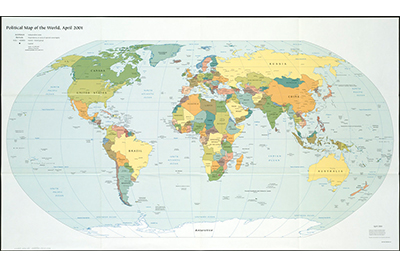
Not being afraid to ask questions
Developing Sensitivities and Awarenesses
Moving Beyond Anti-Bias Activities: Supporting the Development of Anti-Bias Practices, Young Children March 2016; Lisa P. Kuh, Debbie LeeKeenan, Heidi Given, Margaret R. Beneke
Being Prepared For Teachable Moments
Working the Process: Entry Points, Feelings, Thinking, Responding, Sharing
Awareness of the Power of Story: Who's Speaking and Whose Stories Are Getting Told
Families’ Internal Conflict Between Assimilation & Retaining Culture
Elements of Culture That Can Be Learned About
Names - Ups and downs to learning their real names
Food - Families are usually very happy to share
Holidays/Holy Days - Families are usually very happy to share
It’s All About LOVE!
Hello World!
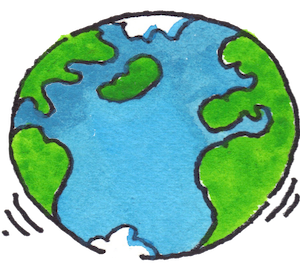
This page is a recap of the ideas, songs and activities covered in Red Grammer's presentation. The links in red will take you (1) to each song's lyric page that features an audio player of the song, videos showing the sign language when available, and links to the song's accompanying activities and (2) to other valuable online resources. Have fun!
Where The World Is Going
Changing Demographics -
USA Today Diversity Index... by County

Interactive Diversity Map by USA Today
Amidst all this change how do we prevent our deeply ingrained socializations about race from hijacking our best selves in racially complicated situations?
Watch this great Ted Talk by Howard Stevenson from the Racial Empowerment Collaborative
The world is getting smaller. And our particular part of the world is getting more diverse.
Which presents us with two questions:
1. Are we teaching our children to be afraid of, or open to, this changing world?
(What will serve them best?)
2. Are we creating classroom environments where our children are accepted, seen and loved for the whole person that they are including the rich culture they represent?
How We Are Different & The Same
In most ways we are the same... we all eat, dress, speak, hope, dream, come from families, and often sing/dance/pray and on and on...
How we express these are a manifestation of our "culture".
Language
The Rapp Song (Tootsie Pops)
I Think You're Wonderful (translations)
I think you’re wonderful… when somebody says that to me
I feel wonderful as wonderful can be
It makes me want to say the same thing to somebody new
And by the way I’ve been meaning to say , “I think you’re wonderful, too”
Russian translation & transliteration
Vwee u di vit ilnee
Kogda eh dta min yeh gu vuhr yat
Syoe u di vit ilna
Ee shast yoo nyet pri grad
Ee min yeh ha teel is bwee
Al vyeht it slova me lub vee
Pro sta ca moo ni bootreeya dum ska zat
Kak u di vit il nee vwee
Hawaiian translation & transliteration
Ku pa-ia na-ha-no-o e
La ha-i-e ha-i ma-i-ai __
Ko mo i ke ku pai a na ha
Me ka nui i hi ki __
E ha i li ke-a ku
Vau i-a ha i hou __
A u a mana o vau e ha-i-a o-e
Ku pai-a naha no oe __
Barnyard Boogie (Rooster crows around the world)

Food
Playfulness
Qualities of Openness
Everyone is welcome here
Curiosity
Where are our students from?

Not being afraid to ask questions
Developing Sensitivities and Awarenesses
The Power of Story:
Who's Speaking and Whose Stories Are Getting Told
Stocking Your Library with Inclusive Children's Titles:
Families’ Internal Conflict Between Assimilation & Retaining Culture
Elements of Culture That Can Be Learned About
Names - Ups and downs to learning their real names
Food - Families are usually very happy to share
Holidays/Holy Days - Families are usually very happy to share
It’s All About LOVE!
"Hello World" Workshop Handout
This page is a recap of the ideas, songs and activities covered in the workshop. The links in red will take you to each song's lyric page that features an audio player of the song, videos showing the sign language when available, and links to the song's accompanying activities. Have fun!
Where The World Is Going
Changing Demographics -
Second immigration wave lifts diversity to record high- COLLISION OF CULTURES, LANGUAGES AND POLITICS POSES PERILS AND PROMISES, USA TODAY, 2014, Greg Toppo and Paul Overberg

Amidst all this change we are walking around
with racial socializations that can impede our best selves
from showing up in racially complicated situtations.
For a great Ted Talk on this go to:
https://www.npr.org/2019/03/29/707193061/howard-stevenson-how-can-we-mindfully-navigate-everyday-racism-how-can-we-mindfully-navigate-everyday-racism
As educators we have a choice...
we can either help our students shield themselves from the "other"...
or embrace the varied members of the world of humanity
with openness, warmth and affection, discernment and an attitude of learning.
If we choose the second, it begins with the realization
that in most ways we are the same.
How We Are Different & The Same
We all eat, dress, speak, hope, dream, come from families, sing, dance, pray, and on and on...
It's the different ways we do these that make life interesting and define "culture".
Language
The Rapp Song (Tootsie Pops)
I Think You're Wonderful (translations)
I think you’re wonderful… when somebody says that to me
I feel wonderful as wonderful can be
It makes me want to say the same thing to somebody new
And by the way I’ve been meaning to say , “I think you’re wonderful, too”
Russian translation & transliteration
Vwee u di vit ilnee
Kogda eh dta min yeh gu vuhr yat
Syoe u di vit inlay
Ee shast yoo nyet pri grad
Ee min yeh ha teel is bwee
Al vyeht it slova me lub vee
Pro sta ca moo ni bootreeya dum ska zat
Kak u di vit il nee vwee
Hawaiian translation & transliteration
Ku pa-ia na-ha-no-o e
La ha-i-e ha-i ma-i-ai __
Ko mo i ke ku pai a na ha
Me ka nui i hi ki __
E ha i li ke-a ku
Vau i-a ha i hou __
A u a mana o vau e ha-i-a o-e
Ku pai-a naha no oe __
Barnyard Boogie (Rooster crows around the world)

Food
Playfulness
Our Bodies
My Son's Realization That He's Brown...
https://www.naeyc.org/resources/blog/my-sons-realization-hes-brown
Qualities of Openness
Everyone is welcome here
Curiosity
Where are our students from?

Not being afraid to ask questions
Developing Sensitivities and Awarenesses
Moving Beyond Anti-Bias Activities: Supporting the Development of Anti-Bias Practices, Young Children March 2016; Lisa P. Kuh, Debbie LeeKeenan, Heidi Given, Margaret R. Beneke
Being Prepared For Teachable Moments
Working the Process: Entry Points, Feelings, Thinking, Responding, Sharing
Awareness of the Power of Story: Who's Speaking and Whose Stories Are Getting Told
Families’ Internal Conflict Between Assimilation & Retaining Culture
Elements of Culture That Can Be Learned About
Names - Ups and downs to learning their real names
Food - Families are usually very happy to share
Holidays/Holy Days - Families are usually very happy to share
It’s All About LOVE!
Each daily lesson should take about 30 minutes.
Day One: Listen to the song Hooray for the World and follow along with lyrics that have been written on a large chart paper. Discuss living and non-living things. Using large chart paper, classify things from the lyrics of the song that are living and non-living.
Day Two: Listen and follow along with the lyrics of the song. When finished, make a class big book ... students tell things that they are happy to have in the world.
Hooray for the World, ________ is glad that _______ is on it.
Earth Day Connection: How can we take care of the earth? List some different ways of taking care of the earth — recycling, taking care of trees and plants.
List all the animals that Red sings about in Hooray for the World. Discuss which ones live above or below the ground and which ones live in or out of water. Have students trace and cut out one of the animals in the song. Paste it on paper. Have the students draw the habitat for that animal.
Materials Needed
1. “Hooray for the World!” – From the recording Teaching Peace
2. 10 Shirts – Large man's short sleeved button down white shirt with a pocket
3. The following animals:
These can either be store bought, made by the students, or brought in by the students. (I used TY Babies® and bought slugs in the fishing department of Wal-Mart™)
|
• Buffalo |
• Beaver |
• Bug |
|
• Bee |
• Bear |
• Poodle |
|
• Jellyfish |
• Bat |
4. The following foods or containers that would have these foods:
|
• Stick of salami |
• Empty container for Chinese food with chopsticks |
|
• Wedge of cheese |
• Bagels with lox |
|
• Bottle of maple syrup |
• Corn on the cob |
|
• Basket of mulberries* |
• Bag of miniature size boxed raisins |
* I can never find mulberries, so I use cranberries
5. Artwork for the following people:
|
• Mom |
• Aunt |
• Gramps |
|
• Dad |
• Brother |
• Neighbors next door |
|
• Uncle |
• Sister |
• Kids down the street |
|
|
• Grandma |
|
(You can use the pictures that we've provided at the end of this lesson, the children can draw their own person, or you can have the children bring in a picture of that person for each shirt.)
Preparation
Each shirt will have one animal and one person to go with it. I like to number the shirt on the inside of the neckline.
Shirt #1 needs a buffalo in the pocket & the Mom on the back of the shirt.
Shirt #2 needs a bee in the pocket & a Dad on the back of the shirt.
Shirt #3 needs a jellyfish in the pocket & an Uncle on the back of the shirt.
Shirt #4 needs a beaver in the pocket & an Aunt on the back of the shirt.
Shirt #5 needs a bear in the pocket & a Brother on the back of the shirt.
Shirt #6 needs a bat in the pocket & a Sister on the back of the shirt.
Shirt #7 needs a bug in the pocket & a Grandma on the back of the shirt.
Shirt #8 needs a poodle in the pocket & a Gramps on the back of the shirt.
Shirt #9 needs a slimy slug in the pocket & Neighbors next door on the back of the shirt.
Shirt #10 needs a slimy slug in the pocket & Kids down the street on the back of the shirt.
Procedure
1. 10 children with the 10 shirts line up left to right and face the audience. The shirts are buttoned down the front and the animals should already be in the pockets. For little children I would make big pockets on the front of the shirt so that the animals can go in and out easily.
2. Put on the song “Hooray for the World!” As the first verse begins, #1 will pull out his buffalo, dance with it, show it off, etc. Follow through until you get to #9 and 10. These children will pull the slimy slugs out of their pockets and wave them in each other's faces as if they are trying to scare each other.
3. For the chorus: As Red sings the children will do the following movements. “Hooray for the World! I'm glad to be on it” – punch up with right hand fist, and repeat 2 more times. “We've got mother nature and the human race” – clap hands, bring up, and to their sides.
4. For the food verse, you will have students in the audience. When their food is mentioned, the children stand up, holding up their item of food. When you get to raisins in a box, the student tosses them out to the audience (Kids love that!).
5. Repeat the chorus.
6. The children are still up on stage standing left to right. When Red starts to sing “We've got moms…” the first child turns around to show the Mom on the back of the shirt. Follow procedure all the way down the line. All children remain with their backs to the audience until Red gets to the line where he sings, “Everywhere you go you've got new friends to meet.” This is when all 10 children turn back to the audience, waving to them.
7. Repeat the chorus.
People Pictures
Click on the images below to see a large image. You can print the large images.
 |
 |
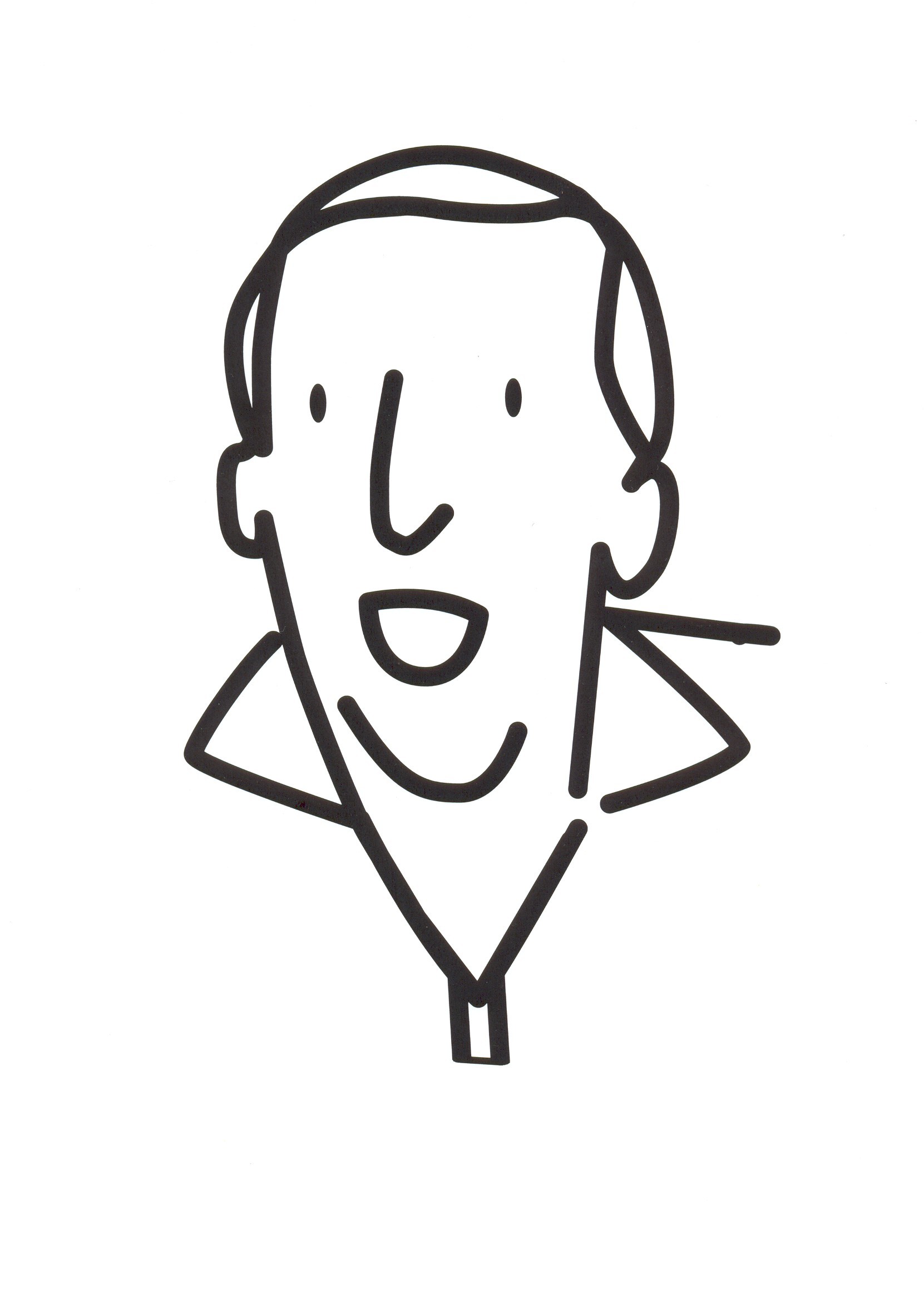 |
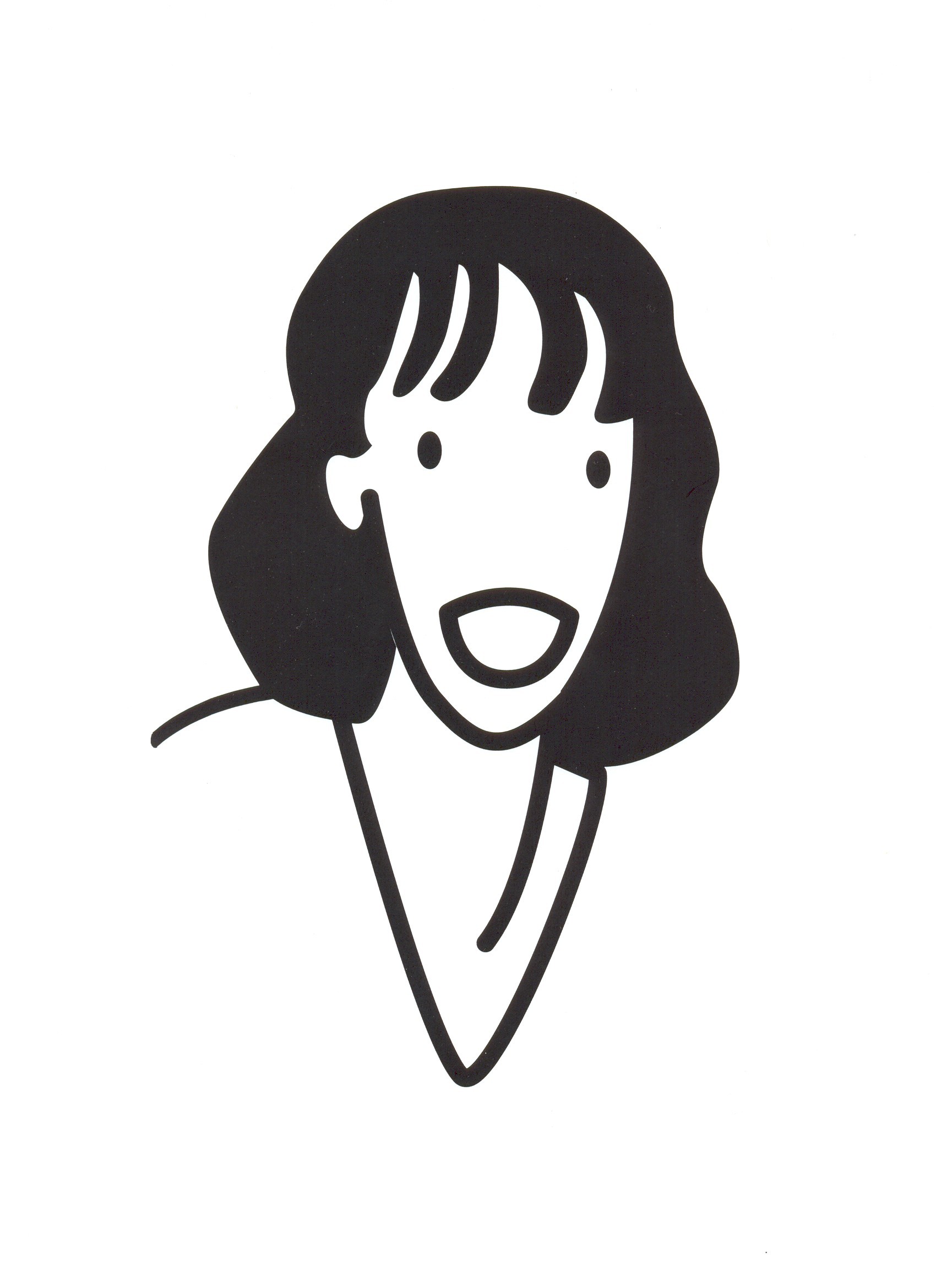 |
|
Mom |
Dad |
Uncle |
Aunt |
 |
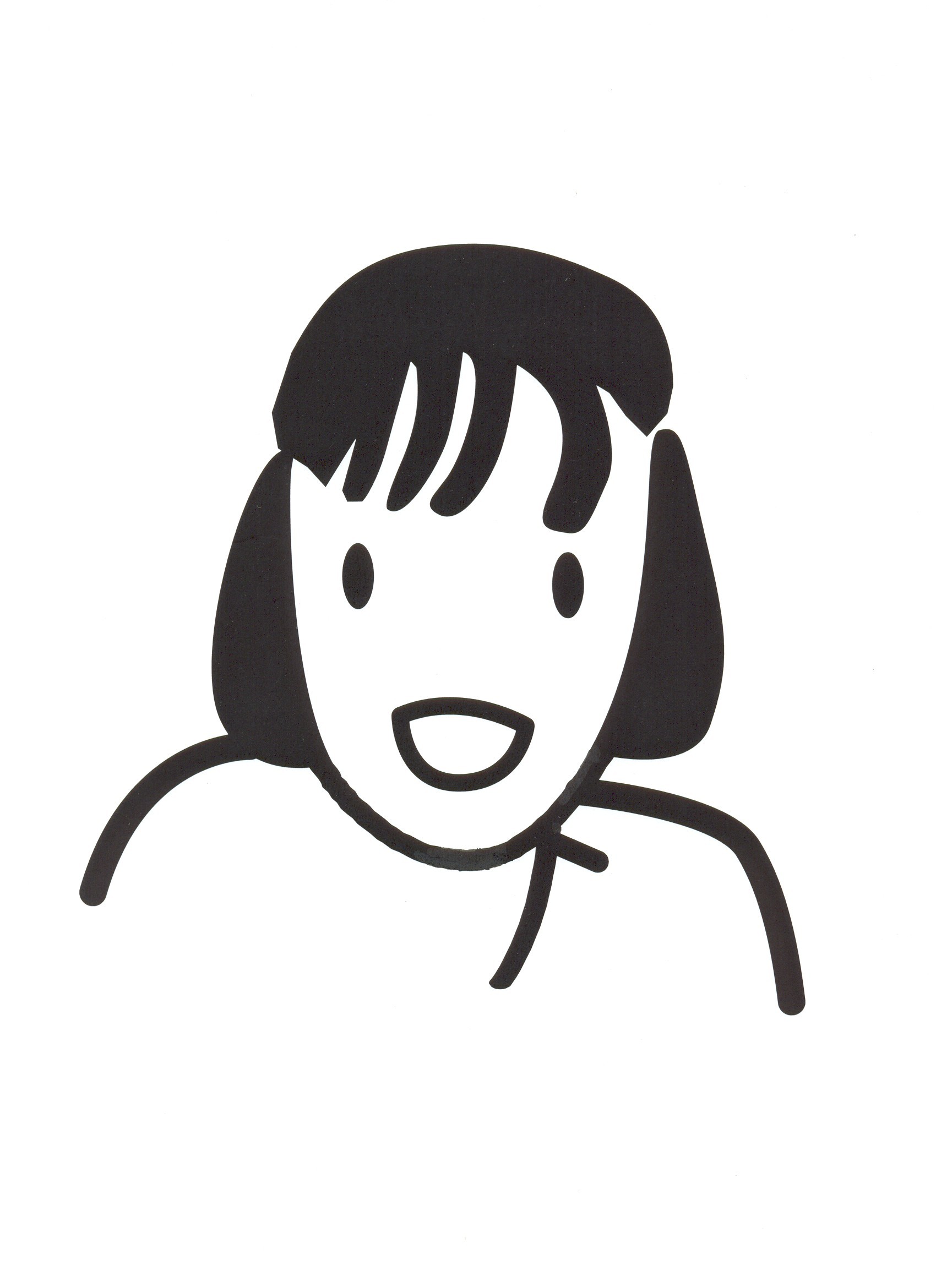 |
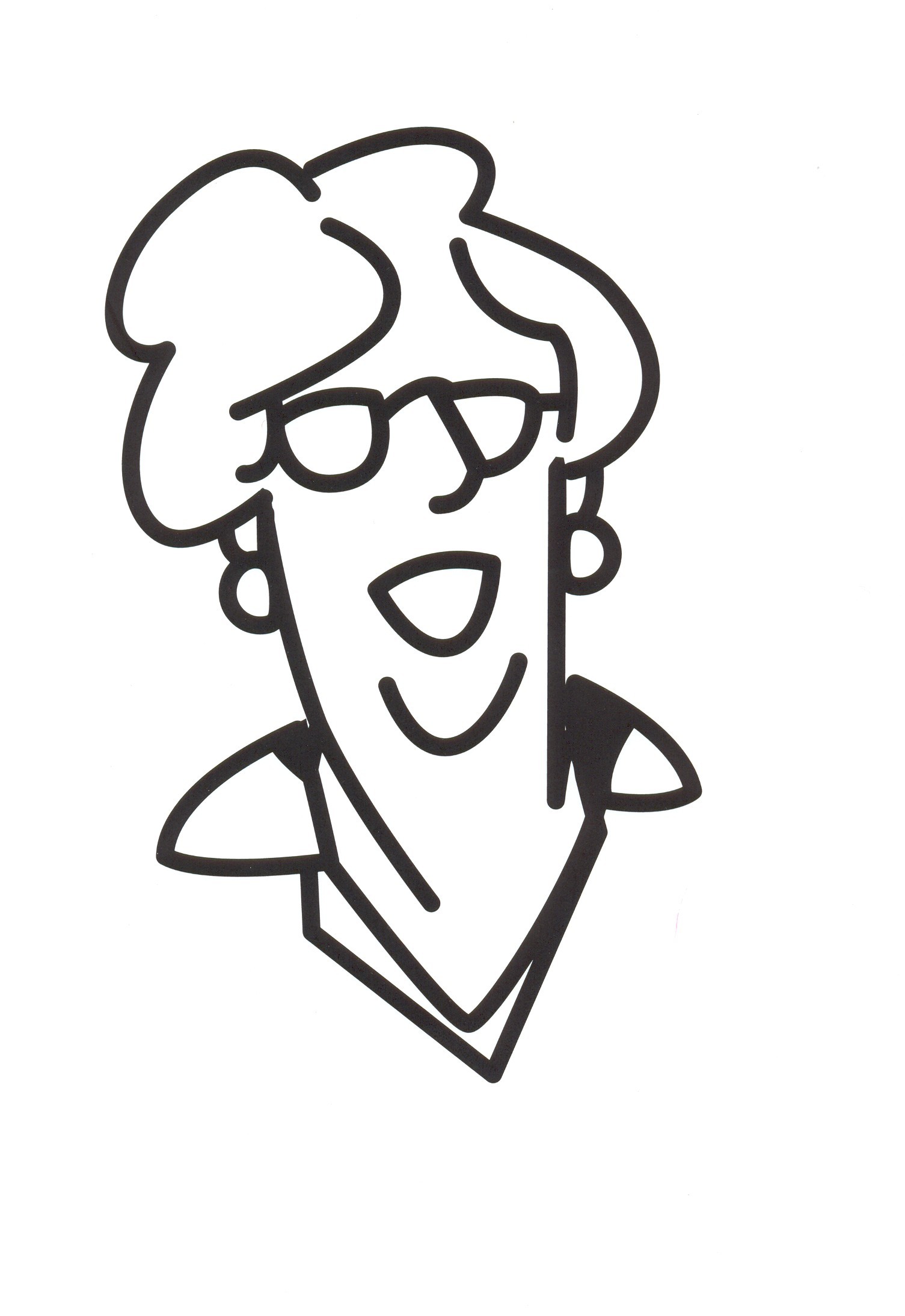 |
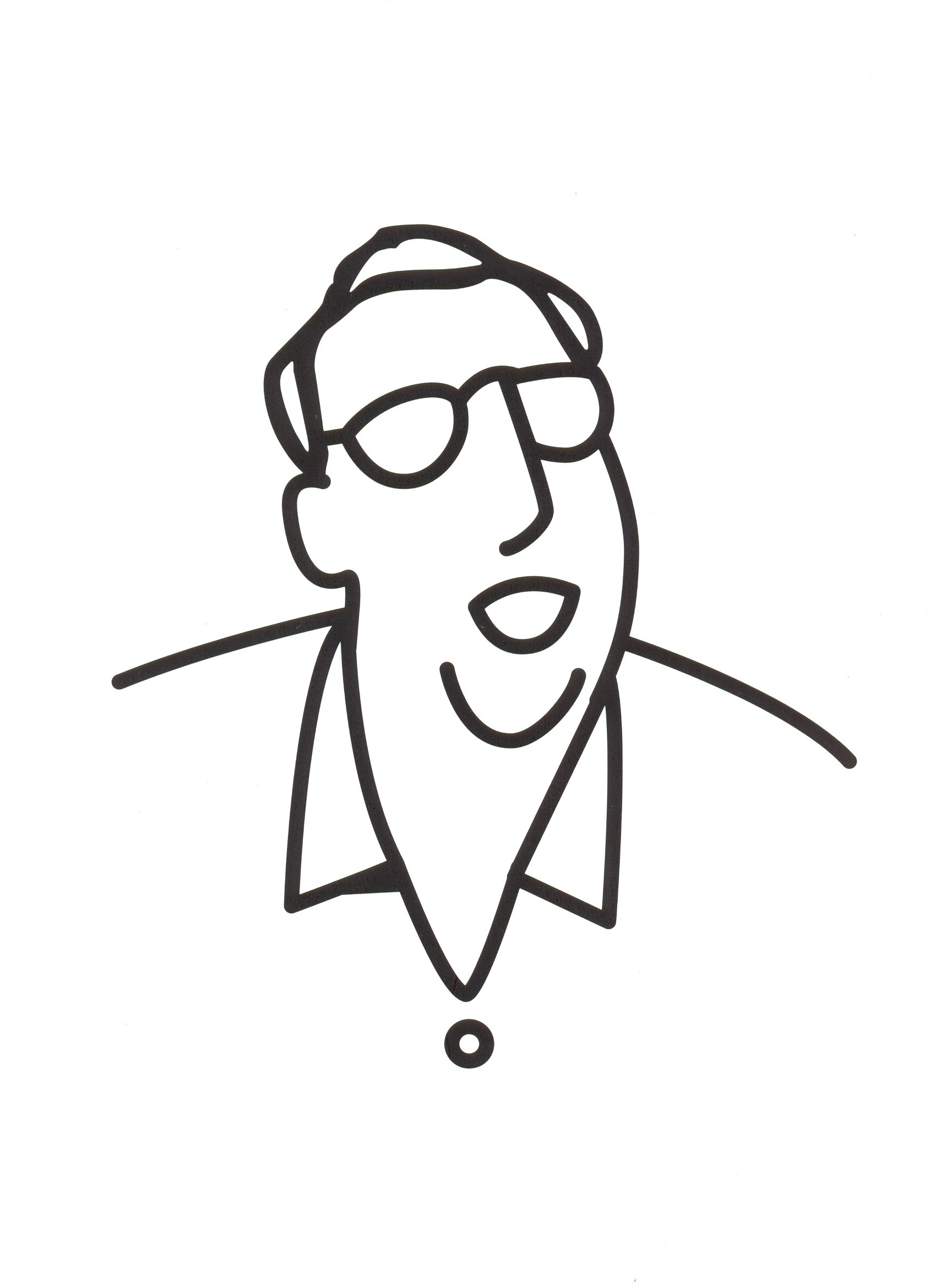 |
|
Brother |
Sister |
Grandma |
Gramps |
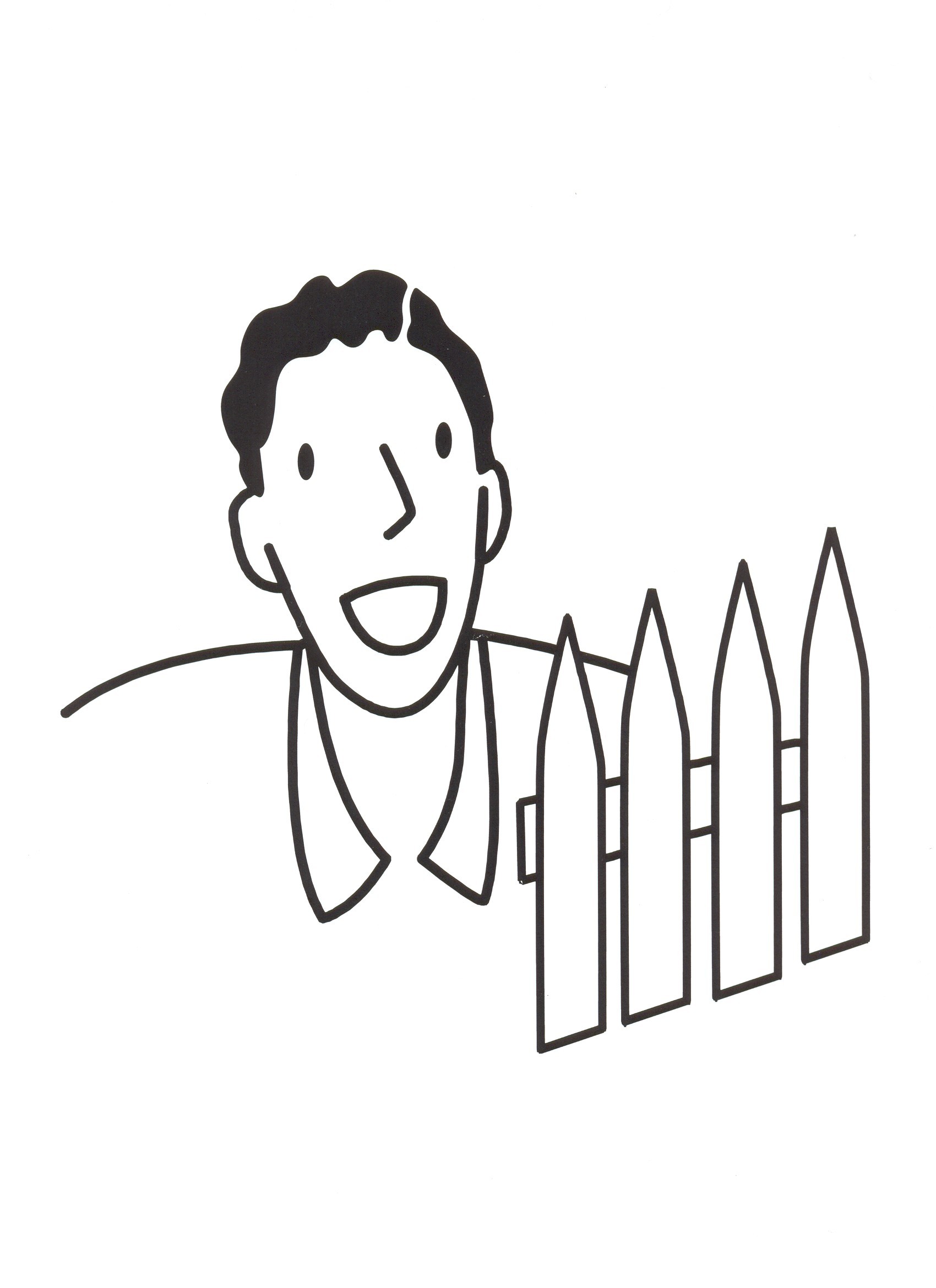 |
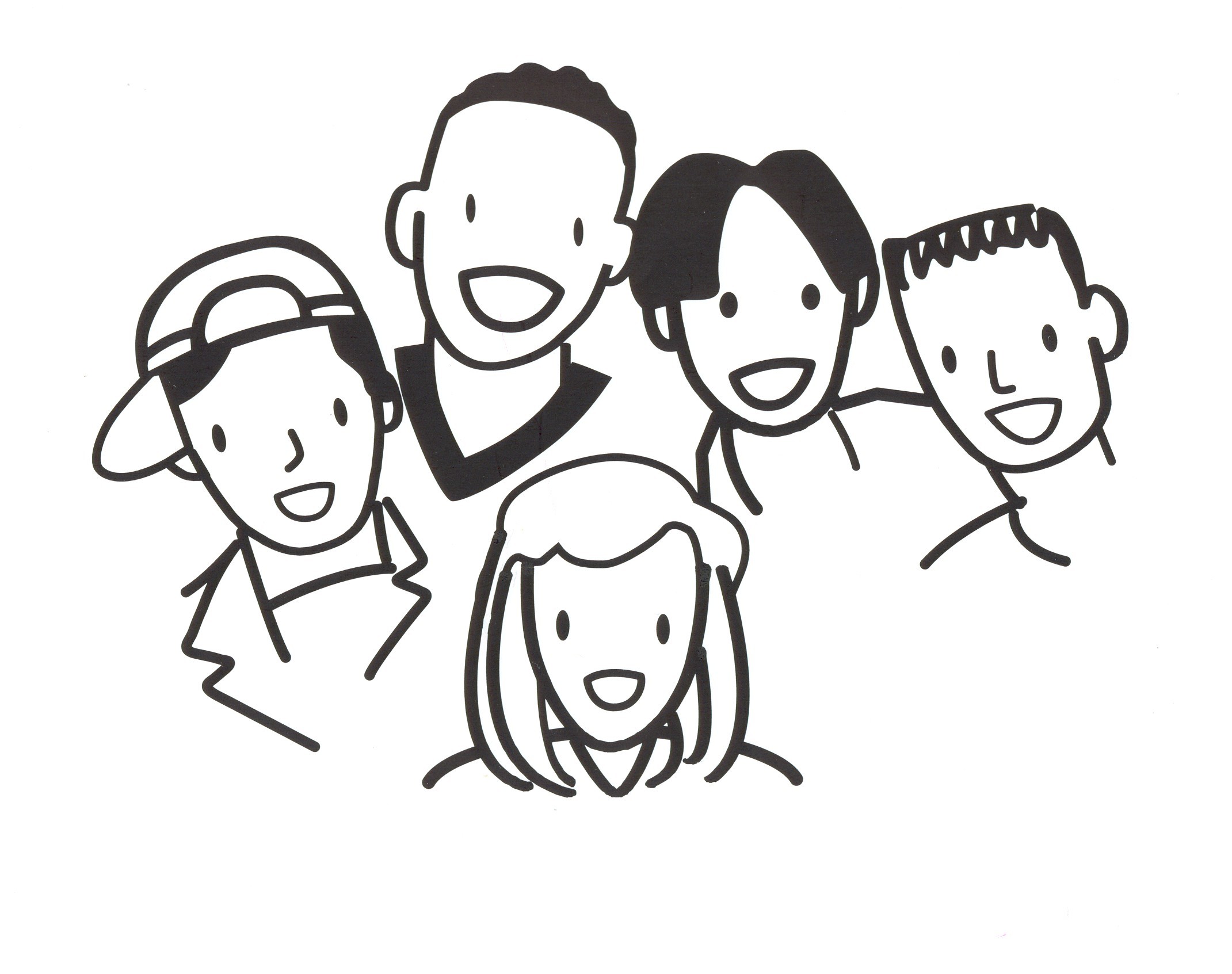 |
||
|
Neighbors |
Kids Down |
Dove Wings
Play the song “I Think You're Wonderful”. When the song is finished talk about all the ways you can be wonderful. You can be a wonderful teacher, parent, sister, brother, aunt, uncle, mom, dad, neighbor, friend, employee, etc. Ask the students to think about all the ways they are wonderful to so many different people. Give each student the body of a dove. Have them trace and cut the body of a dove out. As the student lists all the ways they are wonderful the teacher writes those words on the body of the dove. Next have the students trace their hands (they may need help) and cut them out. These are the wings to the dove. Ask them to list all the wonderful kinds of people in their lives. Their responses are endless ... mom, day, uncle, aunt, grandfather, mailman, cousin, brother etc. Then have the students glue the hands to the body of the dove to show how these wonderful people are connected to them. This activity may take a few days and may be with some help from home. Other songs by the Grammer's that could be used with this project are Teaching Peace and With Two Wings. When this activity is complete you can hang the doves in your classroom or hang them up on stage for an assembly program.
A Wonderful Flower
A Lesson for Grade levels K-1 (Could be modified for preschool)
Each lesson should take about 30 minutes.
Day One: Brainstorm on a chart what a friend is or what friends sound like when they are talking to each other. Sing and teach students I think You're Wonderful. Write the lyrics out on chart paper for the students to follow along. Discuss the words from the song. Check the brainstorming sheet to see if any lyrics from the song match the things that they thought of for showing friendship. Point that out to students.
Day Two: Sing song and role-play things students could say to each to make them feel good. Use lyrics from the song and ideas students came up with on Day One (chart).
Day Three: Play and sing song. Using magazines and large poster board, have students find pictures of people who are showing friendship and kindness. Students work in cooperative groups of 3-4 or in pairs. Cut out pictures and glue onto poster board. A variation would be to give groups of students a circle that is going to be the center of the flower. Write the word Friends in the middle. Have students cut out petals and think of describing words for friends (wonderful, caring, appreciative, loyal, etc) and write those words on the petals. Glue the petals around the center of the flower. Add stems/leaves and hang on bulletin board that looks like a garden of friendship.
Day Four: Students sing and read lyrics from song. Then students share posters they made on day three with other students in their class.
Materials:
- camera
- construction paper
- sign language for the chorus to I Think You're Wonderful (see below)
- rings to bind construction paper together.
- The song, I Think You're Wonderful from Red Grammer's recording, Teaching Peace
Chorus:
- I think you're wonderful
- When somebody says that to me
- I feel wonderful
- As wonderful can be
- It makes me want to say
- The same thing to somebody new
- And by the way I've been meaning to say
- I think you're wonderful, too
Chorus with Signs:
In the chorus above the underlined words are the words that you will sign in the song.
Listed below is how to sign those words
I Pinkie pointing up, hand is placed at the chest.
Think point to your temple
You're point away from yourself
Wonderful Throw both open hands up, palms facing forward
Says The index finger, pointing to the left, is held in front of the mouth and rolls forward in a circular movement.
Me point to yourself
Feel Place the tip of the middle finger against the chest with the other fingers extended; draw it up a short distance.
Be The letter "B" is held against the mouth. Move it away from the mouth, still in an upright position.
Makes Right fist on top of left fist; Turn them in opposite directions and strike them together again. Repeat several times.
Want Place both curved hands in front of you. palms up and draw them toward you several times.
Somebody Hold up the right index finger and shake the arm back and forth slightly, left to right. Palm side may face forward or self.
New The left hand open hand faces up;the back of the right open hand brushes across the heel of the left from right to left.
Way Place both open hands in front of you, fingers pointing forward and palms facing each other; move both hands forward with a slight zigzag motion.
Meaning Right hand makes a "V" like "victory". The fingertips of the right handed "V" are placed against the left open hand, the "V" facing out; the "V" is turned and again placed into the palm, the "V" facing in.
Too Pinkie and thumb are out; move hand forward and backward.
Procedure:
- Play the song, I Think You're Wonderful, for students to learn.
- Teach the students the sign language to the chorus of I Think You're Wonderful.
- Take a picture of students performing the sign language to I Think You're Wonderful and glue the pictures to construction paper.
- Hang the pictures on the bulletin board in the correct order.
- Later on, take the pictures down and put them together with rings to form a book. Students can take turns bringing the book home to share with their families.
NOTE: A teacher form Philomath, OR sent this idea to Red. If you would like to share one of your classroom activities using Red Grammer's songs you can send it to maria@redgrammer.com
I Think You're Wonderful Coupon
Coupons
Coupons can come in all shapes and sizes. I have made little ones, 8 x 10s, and even poster sized coupons when I want to really emphasize how wonderful someone is.
Materials Needed
Poster board and colored markers
Kraft Paper Kids
Materials Needed
Large rolled paper, the kind that you can trace a child's body on, double the length of one child's body
Crayons, Scissors, Markers
Small heart-shape stencils
Some kind of available stuffing, I used old rags, but you could use newspaper, shredded paper, pantyhose, material, etc.
Children's clothing
1. Have kids lay on the paper that is folded in half so that when you cut it out, you are cutting out the body two times. Trace around the child. Cut out the body. Staple or glue all around the edges until its almost closed and then stuff it and finish closing. The body will now have a 3-D effect.
2. Have students bring in their own clothing. They will need a top, a bottom, and foot apparel. Some kids like to add hats or jewelry.
3. Have the kids draw their own faces on the body. I've seen kids add their birthmarks, nail polish, unique hair coloring, etc. While they are doing this, you could be playing “I Think You're Wonderful.”
4. At another time, play “I Think You're Wonderful” for the students and have a discussion about what wonderful means.
5. Ask every student in class to list something wonderful about each and every student. For example, Johnny is in your class and you ask all the students to tell something wonderful about Johnny. Do that for every child in the class.
6. Have each student trace and cut enough hearts for every student in the class. So if you have 12 students, each student needs to cut out 12 hearts.
7. Either the teacher or the student writes something wonderful about every student in the class. Then you take all the wonderful things said about Johnny and pin them all over Johnny's cutout body and clothing. Then, fix the cutout bodies so they are in the chairs where the students normally sit. Now the students are ready for open house.8. When parents come to open house, they not only see the cut-out body of their child, but they also get to read all the wonderful things the class says about their child.
"I Think You're Wonderful" notes and coupons
(This is an on-going lesson and an example of an “I Think You're Wonderful” coupon follows this lesson)
1. Play “I Think You're Wonderful” and discuss the song with the class.
2. The teacher goes around the room and says something wonderful about each and every student.
3. On another day, the teacher plays “I Think You're Wonderful,” has a student stand up, and has the other children say something wonderful about this student. You can continue to go around the room or do another child each day.
4. The teacher slips “I Think You're Wonderful” notes to the students in the class for a period of 1-2 weeks.
5. The teacher hands out “I Think You're Wonderful” coupons and then asks the students to pass them on to someone else in the class.
6. Students are now instructed to pass the “I Think You're Wonderful” coupons to other people in the school, such as secretaries, custodians, other students, principals, nurse, etc.
Kraft Paper Kids
Materials Needed
Large rolled paper, the kind that you can trace a child's body on, double the length of one child's body
Crayons, Scissors, Markers
Small heart-shape stencils
Some kind of available stuffing, I used old rags, but you could use newspaper, shredded paper, pantyhose, material, etc.
Children's clothing
1. Have kids lay on the paper that is folded in half so that when you cut it out, you are cutting out the body two times. Trace around the child. Cut out the body. Staple or glue all around the edges until its almost closed and then stuff it and finish closing. The body will now have a 3-D effect.
2. Have students bring in their own clothing. They will need a top, a bottom, and foot apparel. Some kids like to add hats or jewelry.
3. Have the kids draw their own faces on the body. I've seen kids add their birthmarks, nail polish, unique hair coloring, etc. While they are doing this, you could be playing “I Think You're Wonderful.”
4. At another time, play “I Think You're Wonderful” for the students and have a discussion about what wonderful means.
5. Ask every student in class to list something wonderful about each and every student. For example, Johnny is in your class and you ask all the students to tell something wonderful about Johnny. Do that for every child in the class.
6. Have each student trace and cut enough hearts for every student in the class. So if you have 12 students, each student needs to cut out 12 hearts.
7. Either the teacher or the student writes something wonderful about every student in the class. Then you take all the wonderful things said about Johnny and pin them all over Johnny's cutout body and clothing. Then, fix the cutout bodies so they are in the chairs where the students normally sit. Now the students are ready for open house.8. When parents come to open house, they not only see the cut-out body of their child, but they also get to read all the wonderful things the class says about their child.
Musical/Mirroring Bucket Filling Cups
For Older Students
Materials:
- Plastic cup for each student
- Semi-circle Styrofoam ball
- Construction paper
- Patterns for stars and hearts
- Pipe cleaners
- Hole punch
- Toothpicks or make slits in Styrofoam
Preparation:
- Trace stars and hearts and cut out
- Glue Styrofoam semi-circle into top of cup
- Add the hearts and stars to the cup by either setting the stars and hearts into slits in the Styrofoam ball or attach toothpicks to hearts and stars and push the toothpicks into the Styrofoam ball
- Punch 2 holes opposite each other at the top of cup
- Slip one end of pipe cleaner in one hole and the other end of the pipe cleaner into the other hole so that the pipe cleaner becomes the handle to the bucket.
Activity:
- Play the song, "I'm All Filled Up" and point out how the children repeat what Red sings.
- Have students listen to the beat that plays in the background.
- Have students pair up or get into groups and create some background music to the song with their cups. Kids love to play cups to music. They can come up with some really good sounds. The cup sounds could be played during the repeated phrases sung by the children in the song.
- Have students share with the rest of the class.
For Younger Students
Materials:
Same as above
Preparation:
Same as above
Activity:
- Tell students that they are going to play the mirror game using their cups (buckets).
- Play the song and the teacher moves the cup a certain way while Red sings the line. The students imitate the teacher's move while the children on the recording repeat Red's line. Do this a couple of times.
- On the same day or on another day, have the students sit in pairs facing each other. this time they take turns playing the mirror game with each other using their cups while the song is playing.

Movements for “I'm Lucky”
created by Cindy Doback
adapted by Red Note Records
In 1998, the hula hoop, one of the biggest fads in history, turned forty years old. To join in the celebration your students can turn a hula hoop into a friendship ring. You will need 1 hula hoop for every 2 students and the song “I'm Lucky" from the recording, “Can You Sound Just Like Me?"
You will need one hula hoop for each group of 2 children and the song, I'm Lucky" from Red Grammer's recording, Can You Sound Just Like Me?
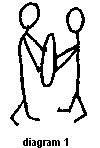
To begin, the students are holding the hoop like a steering wheel (diagram 1).
Verse 1
“The great big wheel goes round and round” - children slowly turn the wheel like you would a steering wheel.
“The sun goes up” - children bend their knees slightly and then stretch up like they are lifting the sun up to the sky. Think of the hoop like a Ferris wheel when it goes half way up.
“The sun goes down” - children come back down around bending their knees. Again, like a Ferris wheel the hoop is on the downward ride.
“We keep living day to day” - The hoop is now to be held horizontally (diagram 2) with both hands and the children spin around slowly in a clockwise direction.
“I look around and I have to say” - Turn slowly in the counter clockwise direction and stop.
Chorus
1. “I'm Lucky” - on the word “I'm” swing the hoop back to the holding position (diagram 3) and on “Lucky” swing the hoop down and then up in a big circle going all the way around and letting your body turn around with it. You will need to pivot to turn.
2. “Spending my life with you” - swing the hoop with both hands back and forth to the beat of the music. Knees are slightly bent and feet are stationary.
3. “You know I'm Lucky” - repeat 1 of chorus.
4. “And I know we're gonna make it through” - repeat 2 of chorus.
Verse 2
“There's no one else in the world like you” -one child holds the hoop like it's a frame for the other child. The child not holding the hoop acts out being the picture for the frame. The child can be creative to act out his/her own "picture”.
“And nobody does things the way you do” - repeat same movement with children swapping parts.
“I wouldn't trade you for anything” - the hoop returns to a horizontal position by the children's waist only instead of holding the hoop with their hands they hook the hoop with an elbow so that each child is facing the same direction and the hand away from the hoop is free. At the same time they are swaying back and forth slowly to the beat of the music.
“You bring a smile to my heart and you make me sing” - still swaying and hooking the hoop with one elbow, each of the children use their free hand to bring it to their face to show a smile, then touch their heart, then swing their free arm out and around and grab the hoop with both hands so as to be ready to start the “Chorus” motions.
Chorus
The chorus repeats 2x. On the last time through when you get to the words “gonna make it through” the children go inside the hoop together by lifting the hoop over their heads.
The Scoop on the Hoop!
The inspiration for the hoop was a large bamboo ring whirled by Australian kids in gym class.
The plastic American version was named the hula hoop after the hip-swiveling Hawaiian dance.
The first hula hoop sold for $1.98 in 1958.
In 1958, the first year on the market, 100 million hula hoops were sold world wide.
The plastic tubing for all the hoops ever made would stretch around the earth 5 times.
When spinning a hula hoop around your hips, speed up to make it travel up your body and slow down to send it toward your feet.
It Looks Like I'm Learning 'Cause I Am
Red Grammer

This page is a recap of the ideas and songs in the presentation. Many of the songs in this workshop are new and are not yet on a recording. For these new songs there are video clips here of me performing the given song in one of my weekly Thursday online concerts. For those on an existing recording the link will take you to each song's lyric page that features an audio player of the song, videos showing the sign language when available, and links to the song's accompanying activities. Have fun!
"Mindset" by Carol Dweck
Fixed Mindset:
We believe that our intelligence, our social abilities, our artistic/athletic/creative skills are set right where they are and will always be.
Anything that is difficult is a moment of judgment in which we will either found to be lacking or to be successful, a high stakes assessment that can trigger a host of possible reactions including fear, withdrawal or shut down, defiance, blame, anger, self-doubt,
all of which impede learning.
Growth Mindset:
We believe that even if we are struggling right now, with effort we will improve and grow.
Challenges are seen as opportunities to learn, to grow, to become more capable, more alive.
This encourages engagement and learning.
“Just the words ‘yet’ or ‘not yet’, we’re finding, give kids greater confidence, give them a path into the future that creates greater persistence.”
Carol Dweck – The Power of Believing That You Can Improve Ted Talk https://youtu.be/_X0mgOOSpLU
Teacher’s Fixed Mindset:
We believe that the intelligence of each student, their social abilities, their artistic/athletic/creative skills, etc. are set, fixed right where they are right now.
We see their fear, withdrawal or shut down, defiance, blame, anger, self-doubt as confirmation of our beliefs and treat the child accordingly.
A Teacher’s Growth Mindset:
We believe that even if a student is struggling with certain skills or understandings right now, their abilities aren't set in stone.
We believe that with nurturance, work, and well-conceived strategies, their skills and comprehension will improve over time.
As educators we see their learning challenges as opportunities for us to learn and to become more capable of helping our students. Finding those solutions brings more satisfaction and life to our work.
If a child believes that they are intrinsically dumb or super smart, the research shows that they either way they will likely be afraid of putting themselves into situations that will either prove correct their belief that they are dumb or prove false their belief that they are super smart.
In both cases they often are disinclined to put in the effort and develop strategies to learn new things.
How To Build A “Growth Mindset” Classroom
Give the right kind of praise:
Praising intelligence or talent leads to a fixed mindset.
Praising effort, persistence and growth leads to a growth mindset.
Fixed Mindset Praise:
“You are a genius!”
“You are a natural!”
“You are SO good at that!”
“You did that so quickly!”
Growth Mindset Praise:
“I love the way you practiced and practiced that.
Look where it got you!”
“I love that you are willing to try new things that are hard. You’re always learning!”
“Well that was obviously too easy. How about we try this other one so you can learn something new.”
Accept and Encourage Mistakes and Imperfection:
If we are in a posture of learning, mistakes and imperfections are viewed as part of the process.
Have a “Failabration” like Brad Montague did with his friends and family. Check out his great Instagram reel that he and his kids created… https://www.instagram.com/reel/CizsqZ1D8wV/?igshid=YmMyMTA2M2Y=
Encourage and Praise Action:
We don’t ever learn if we don’t try!
Encourage and Praise Persistence:
Encourage and Praise Creative Approaches:
Breathe:
Have Fun!
Learning new things and developing competence is the most exciting thing in the world for a child if they have a growth mindset.

Materials Needed:
- Fun Foam visors. They can be found in Wal-Mart for .78
- Markers
- The song, It's Another Beautiful Morning from the recording, Can You Sound Just Like Me? by Red Grammer
Activity 1:
- Play the song, It's Another Beautiful Morning
- Talk about the song and be sure to mention that in the song the child "Tipped his hat to everyone" "Smiled to everyone" "Waved to the neighbors"
- Explain to children that it is important that we greet each other in a friendly way. Hal Urban, a teacher for over 35 years, greets his students in the hallway each and everyday as they enter his classroom. The students are the most polite students at the high school level and substitute teachers want to sub in his class! Hal says that he had to teach the students the basics...saying Hello in a proper way. Making eye contact. Reminding the students to say Please and Thank You.
- Prepare a script for students to take turns practicing:
Student 1: Good Morning, Mary
Student 2: Good Morning, Jamal. How are you?
Student 1: I am fine. How are you?
Student 2: I am fine, thank you.
Student 1: Have a nice day!
Student 2: Thank You. You have a nice day, too!
Student 1: Good-bye!
Student 2: Good-bye!
The students will be wearing the fun foam visors. They should tip the hat when saying good morning and tip the hat when saying good-bye.
Activity 2:
On another day talk to the students about the different ways to say "hello" in different languages. ( You can also use the Rapp Song from the Parents' Choice Award-winning recording, "Teaching Peace" for this activity).
Write "hello" in a different language on each fun foam visor. Have the students try another script using the "Hello" from their visor. After they have practiced, let them wear their hat around the building and they can greet others with their "hello" and they can tip their hat!

